How Can Law Firms Use AI in Litigation?
How Can Law Firms Use AI in Litigation?
Legal work takes time—lots of it. Attorneys spend hours on research, discovery, and drafting documents, and the workload never really slows down. But AI is changing the game to make litigation faster and a lot less tedious.
From automating routine tasks to pulling up relevant case law in seconds, AI is helping law firms work smarter. It’s improving accuracy, cutting costs, and freeing up time for the legal work that actually matters—strategy, client advocacy, and winning cases.
So, how does AI fit into litigation? What are the real benefits and the potential drawbacks? And what does this mean for the future of the legal profession?
This guide covers everything you need to know—from how law firms are using AI to how tools like Briefpoint are saving attorneys hours on discovery responses. Whether you’re already experimenting with AI or just curious about what’s next, this breakdown will give you a clear picture of AI’s role in modern litigation.

The Applications of AI in Litigation
Legal work is getting a boost from AI. Litigation is faster, more streamlined, and a lot less tedious, thanks to AI. Lawyers can now focus on the important parts of their job. Here’s how it’s being used in litigation today.
1. eDiscovery
Discovery is one of the most time-consuming parts of litigation. Finding the right stuff in a sea of emails, contracts, and case files takes forever. Lawyers and their assistants can spend weeks on this alone.
AI-powered eDiscovery tools take the heavy lifting off legal teams by scanning massive amounts of data in minutes.
Think of it like this: people reviewing things manually miss things. These tools, using machine learning, are much better at finding patterns, spotting errors, and highlighting important details. They’re much more accurate.
Instead of digging through endless documents, attorneys get a prioritized list of the most relevant files, making it easier to focus on building their case.
Besides saving you time, AI helps prevent those annoying little mistakes we all make sometimes. Overlooking evidence weakens any argument. But AI catches everything to minimize that problem.
With tighter deadlines and increasing data volumes in litigation, AI-driven eDiscovery helps firms stay ahead without getting buried in paperwork.
2. Legal Research
Finding the right case law, statutes, and legal precedents takes up a significant portion of an attorney’s time. Research platforms using AI speed things up; they quickly find the right cases and give you the main legal points.
Instead of manually combing through databases, lawyers can rely on AI to surface the most applicable rulings in seconds.
A few platforms offer case comparisons to show where arguments might fall short. Attorneys use this to make their strategies sharper.
Less time researching means more time crafting winning arguments for your clients.
3. Drafting Legal Documents
Legal document drafting is another area where AI is making a difference. Whether it’s responding to discovery requests, preparing contracts, or reviewing your legal writing, AI-powered tools automate much of the process with generative AI and large language models.
Generative AI tools generate templates based on past cases and legal best practices. Imagine trying to build a house without a blueprint. These tools are like that blueprint, making sure everything is done correctly and nothing is forgotten.
Essentially, using AI for writing is great for saving time; it handles a lot of the grunt work, but human review is still necessary.
A great example of this is Briefpoint, an AI-driven platform designed to handle discovery responses efficiently. Instead of spending hours drafting responses manually, attorneys can use Briefpoint to generate high-quality, customized discovery documents in minutes.
The tool automates formatting, inserts relevant objections, and structures responses based on legal standards—saving firms time and reducing errors.
By integrating AI-powered tools like Briefpoint, attorneys can focus more on case strategy and client advocacy rather than getting bogged down by repetitive paperwork.
4. Case Strategy and Predictions
One of AI’s most powerful applications in litigation is predictive analytics.
Using past cases and their results, AI can figure out the probable outcome of a new case. It does this by also looking at settlement patterns. Better decisions about settling versus trial are easier for attorneys with this information.
Some AI tools even assess the strengths and weaknesses of different legal arguments so lawyers can fine-tune their approach. While AI can’t guarantee an outcome, it provides valuable insights that help firms manage risk and develop stronger case strategies.

5. Compliance and Risk Management
AI is also playing a key role in regulatory compliance. Law firms dealing with highly regulated industries—such as finance, healthcare, and corporate law—use AI to review contracts and agreements for compliance risks.
Legal issues? These tools will flag them. Need contract revisions? They’ll suggest them. Want to compare your new contract to past agreements? These tools make it easy to achieve better consistency.
Firms can sidestep costly legal battles by automating compliance checks; this helps prevent missing important requirements.
6. Contract Review and Analysis
Reviewing contracts manually can take hours, especially for firms handling large volumes of agreements.
Contracts get a speed boost from AI; it spots inconsistencies, missing pieces, and possible problems. It can also compare agreements against previous versions to highlight any changes that may impact legal standing.
AI-powered contract analysis tools don’t just speed up reviews—they improve accuracy by catching details that a human reviewer might overlook.
This is particularly useful for transactional law, mergers and acquisitions, and employment agreements, where small errors can lead to significant legal consequences.
7. Client Communication and Chatbots
While AI won’t replace direct client interactions, it can make communication more efficient. Some law firms use AI-powered chatbots to handle routine inquiries, schedule consultations, and provide basic legal information. Lawyers gain extra time; clients get quicker responses.
Chatbots can’t offer legal advice, but they can assist with initial intake, document collection, and FAQs. Clients can access law firms more easily, and it doesn’t mean more work for the firms.
8. Fraud Detection and Investigations
Finding fraud and misconduct is easier with AI, mainly because it’s really good at picking up patterns in huge data sets.
Law firms and corporate legal departments use AI to analyze financial records, contracts, and communications for suspicious activity. Spotting possible fraud is easier for legal teams thanks to these tools, which identify irregularities. Investigations become more efficient as a result.
AI is particularly useful in white-collar crime cases, regulatory investigations, and corporate compliance audits, where finding key evidence quickly can make a significant difference.
What Are The Benefits of Adopting AI Into Your Practice?
AI isn’t just about speeding up processes—it brings real, measurable advantages to law firms. By handling repetitive legal tasks, improving accuracy, and reducing costs, AI allows attorneys to focus on strategy, client relationships, and complex work.
Here’s how integrating AI into your practice can make a difference.
Faster, More Efficient Workflows
Legal work comes with a ton of paperwork, research, and repetitive tasks, especially during litigation. AI takes a lot of that off an attorney’s plate by speeding up processes like document review and case research.
For example, generative AI models and natural language processing (NLP) can help you draft documents in minutes instead of the hours (or days) it would usually take.
So, instead of spending eternity digging through discovery documents or searching for relevant case law, AI can pull up what’s needed in minutes. That means lawyers can focus more on case strategy and less on tedious admin work.
Cost Savings
Law firms run on billable hours, but not all billable work adds real value.
Automating routine tasks like legal research and document creation with AI offers substantial cost reductions. This efficiency boost translates directly to the bottom line for businesses. For example, a law firm could reduce its administrative costs by 15% or more.
Take Briefpoint, for example—it slashes the time attorneys spend drafting discovery responses, saving firms around $20,477 per year, per attorney. That’s money that can be reinvested into client service, firm growth, or even taking on more cases without overloading the team.
Improved Accuracy and Reduced Errors
Even the best attorneys can miss small details when reviewing stacks of documents. AI provides an extra layer of accuracy by flagging inconsistencies, spotting missing clauses in contracts, and identifying compliance risks before they become problems.
It won’t replace human judgment, but it can help make sure nothing slips through the cracks. With AI handling the heavy lifting, legal teams can be more confident that their research and filings are rock-solid.
Better Decision-Making
By analyzing past rulings, settlement trends, and even judge behavior, AI can predict case outcomes with surprising accuracy. Before court or settlement talks, this gives lawyers a much better idea of their likelihood of success.
High-stakes litigation? Forget relying solely on intuition. Data-driven strategies provide a powerful competitive edge.
More Time for High-Value Work
Legal work isn’t just about filing motions and drafting contracts—client relationships and courtroom strategy matter just as much. AI helps attorneys shift their focus from repetitive admin tasks to the work that truly moves the needle.
Because AI now does the legwork of research, document preparation, and compliance reviews, lawyers have more time for the things that really matter: building winning cases, negotiating fair settlements, and providing expert advice to their clients.
This means better representation for everyone.
Better Client Service
Clients want quick answers and timely updates, and AI helps law firms deliver just that. Chatbots and virtual assistants can handle basic client inquiries, schedule meetings, and even help with initial case intake.
AI-powered document automation tools also speed up response times, so clients aren’t left waiting on paperwork. Ultimately, this results in a more seamless experience for clients and less back-and-forth for attorneys.
Scalability for Law Firms
Growing a law firm takes more than just adding new attorneys—it requires efficient processes. AI makes it easier for firms to scale without hiring an army of associates.
Smaller businesses can handle a bigger caseload by automating their busywork. This prevents them from becoming overloaded.
It’s a win-win: Smaller legal practices can compete with larger ones by providing excellent service at a reasonable cost. This means clients get quality representation without the hefty price tag.
Are There Any Limitations or Drawbacks to AI-Powered Litigation?
AI is a powerful tool, but it’s not perfect.
One of the biggest concerns is that AI lacks human judgment. While it can analyze documents, predict case outcomes, and automate research, it doesn’t understand legal nuances the way a trained attorney does. Complex cases require strategic thinking, negotiation skills, and ethical considerations that AI simply can’t handle.
Bias is another issue. AI learns from the past. So, if past court cases showed bias, the AI might repeat those same mistakes. Attorneys must check AI suggestions; otherwise, predictions and recommendations might be biased.
There’s also the matter of cost and implementation. While AI can save money in the long run, high-quality legal AI tools require upfront investment and ongoing training. Firms must integrate these tools into their workflow and make sure staff knows how to use them effectively.
Don’t forget the laws and the moral side of things. These are critical considerations. Legal work from AI needs a lawyer’s check to make sure it’s right and follows all the rules.
Courts may also challenge AI-generated filings or arguments, making it clear that while AI can assist in litigation, it won’t be replacing attorneys anytime soon.
What Does AI Mean For the Future of the Legal Profession?
The legal field is changing thanks to AI, and it’s happening faster than most people thought. When OpenAI first released ChatGPT, most law firms weren’t paying much attention.
A survey from Thomson Reuters found that only 3% of attorneys and law firm staff were actually using AI, and 60% had no plans to adopt it. Even firms that were considering AI were hesitant to implement it in real legal work.
Less than a year later, the landscape had completely shifted. A follow-up survey of top U.S. law firms revealed that AI was already making an impact.
While many firms initially limited its use to internal tasks that didn’t involve client data, nearly half of the Am Law 100 firms had started actively using AI for legal research, business operations, and case strategy.
This rapid adoption shows that AI isn’t just a passing trend for the legal industry—it’s a fundamental shift in how legal work gets done. While AI won’t replace attorneys, firms that embrace it will be better positioned to stay competitive, improve efficiency, and provide faster, more accurate legal services.
Your Discovery Process Doesn’t Have to Be a Drag
Here’s a clear fact—litigation comes with a lot of tedious work. You didn’t become a lawyer to spend hours drafting discovery responses or digging through endless case files. And this is exactly why AI is becoming more and more of a necessity for legal professionals these days.

Adopting AI is all about giving you the tools to work faster and more efficiently. The firms that embrace AI aren’t drowning in paperwork. They’re focusing on case strategy, client advocacy, and winning.
If you’re tired of spending hours on discovery drafting, Briefpoint makes it simple. Generate structured, professional responses in minutes instead of wasting valuable time on formatting and repetitive edits. More efficiency means more time for legal work that actually matters!
See what it can do for your legal practice—schedule a Briefpoint demo today.
Make Your Litigation Workflows More Value-Adding
Discovery responses cost firms $23,240, per year, per attorney. $23,240 estimate assumes an associate attorney salary of $150,000 (including benefits – or $83 an hour), 20 cases per year/per associate, 4 discovery sets per case, 30 questions per set, 3.5 hours spent responding to each set, and 1800 hours of billable hours per year.
Book a demo and save on these costs with Briefpoint.
FAQs About AI in Litigation
How is artificial intelligence used in litigation?
AI helps law firms with tasks like eDiscovery, legal research, document drafting, and case analysis. It speeds up data-heavy processes, reducing the time attorneys spend sorting through documents and finding relevant case law. Some firms also use AI-powered predictive analytics to assess case outcomes and optimize their legal operations.
How can AI be used in the legal profession?
AI is transforming the legal profession by automating routine tasks, improving research accuracy, and streamlining contract analysis. Law firms (and even law schools) use AI for document review, compliance checks, fraud detection, and even client communication through AI-powered chatbots.
How is AI being used in court?
While AI doesn’t argue cases, it assists attorneys and judges by organizing case materials, analyzing past rulings, and identifying key precedents. Some courts use AI-powered tools for legal research, while others explore AI-driven case management systems to improve efficiency. However, AI-generated arguments and filings still require human oversight to meet legal and ethical standards.
What are the AI lawsuits in 2024?
Several lawsuits in 2024 involve AI, focusing on issues like copyright infringement, data security, and liability for AI-generated content. Some cases challenge how AI models use copyrighted materials for training, while others address concerns over AI bias and its impact on legal decisions. Courts are also reviewing regulations on AI use in various industries, with a particular focus on compliance with laws like the California Consumer Privacy Act (CCPA). As AI continues to evolve, legal battles are shaping future standards for data protection, intellectual property, and responsible AI deployment.
The information provided on this website does not, and is not intended to, constitute legal advice; instead, all information, content, and materials available on this site are for general informational purposes only. Information on this website may not constitute the most up-to-date legal or other information.
This website contains links to other third-party websites. Such links are only for the convenience of the reader, user or browser. Readers of this website should contact their attorney to obtain advice with respect to any particular legal matter. No reader, user, or browser of this site should act or refrain from acting on the basis of information on this site without first seeking legal advice from counsel in the relevant jurisdiction. Only your individual attorney can provide assurances that the information contained herein – and your interpretation of it – is applicable or appropriate to your particular situation. Use of, and access to, this website or any of the links or resources contained within the site do not create an attorney-client relationship between the reader, user, or browser and website authors, contributors, contributing law firms, or committee members and their respective employers.
Discovery Objections Cheat Sheets: Full Guide
Discovery Objections Cheat Sheets: Full Guide
Handling discovery requests is a necessary but time-consuming part of litigation. Whether you’re responding to interrogatories, requests for admission (RFAs), or requests for production (RFPs), objections can help you protect your client and limit unnecessary disclosures.
Want a quick reference guide to common discovery objections? Use the Discovery Objections Cheat Sheet today.
Discovery Objections Overview
Discovery objections let you challenge or limit a request from the opposing party. They help:
- Protect privileged information
- Prevent fishing expeditions (overly broad or burdensome requests)
- Ensure relevance to the case
- Avoid unnecessary delays and costs
Each jurisdiction has its own rules, but objections must always be specific and justified. Courts don’t like blanket objections that lack detail or seem like stalling tactics.

What Are Common Objections to Discovery Requests?
Here’s a breakdown of common discovery objections and when they apply:
1. Relevance
A relevance objection is used when a discovery request seeks information that has no connection to the claims or defenses in the case.
Courts generally allow broad discovery, but requests must still be reasonably related to the legal issues at hand. If a request asks for irrelevant, outdated, or unrelated information, you can object on these grounds.
However, it’s important to explain why the request is irrelevant rather than just stating the objection.
Example: “Objection. The requested documents concern events that occurred outside the relevant time frame and have no bearing on the issues in dispute.”
Remember: A strong relevance objection should specify why the request is irrelevant while still complying with discovery obligations where necessary.
2. Overbroad and Unduly Burdensome
An objection for being overbroad and unduly burdensome comes into play when a discovery request isn’t clear, asks for too much, or takes way too much time and effort to respond to.
Courts allow broad discovery, but they also expect requests to be reasonable. If a request doesn’t set clear limits on time, subject matter, or scope, it can turn into a massive task that eats up unnecessary resources. But just saying a request is “too broad” isn’t enough—courts want to see why it’s a problem.
Example: “Objection. This request is overbroad and unduly burdensome as it seeks ‘all documents’ related to the matter, without any reasonable limits on time or subject.”
If only part of the request is overbroad, you should respond to the reasonable portion while objecting to the rest. Courts prefer narrowing requests rather than outright refusal, so offering to meet and confer can help avoid disputes.
3. Privileged Information
An objection for privileged information is used when a discovery request asks for materials protected by attorney-client privilege, work product doctrine, or other legal protections.
Courts take privilege seriously, but objections need to be specific—you can’t just claim privilege without explaining why the information is protected. If you withhold documents, you’ll likely need to provide a privilege log listing what’s being withheld and why.
Example: “Objection. This request seeks information protected by the attorney-client privilege and is therefore not subject to disclosure.”
If only part of the response is privileged, courts expect you to produce the non-privileged portions while redacting the protected content.
Keeping a detailed privilege log can help avoid challenges and show that you’re withholding information for a valid reason, not just to block discovery.
4. Vague or Ambiguous
An objection for being vague or ambiguous applies when a discovery request is unclear, confusing, or open to multiple interpretations. If the wording is too broad or poorly defined, it can be difficult to know exactly what’s being asked.
Courts expect objections to be reasonable, so if a request can be clarified, it’s often better to ask for clarification rather than refuse to respond altogether.
Example: “Objection. This request is vague and ambiguous as it fails to define the term ‘relevant communications,’ making it unclear what is being sought.”
5. Confidential or Private Information
An objection for confidential or private information is appropriate when a discovery request asks for sensitive business data, personal records, or legally protected material. While courts recognize the need for broad discovery, they also expect parties to protect trade secrets, financial details, medical records, and other confidential data.
Simply labeling something as “confidential” won’t be enough—if the information is relevant, a court may allow disclosure under a protective order to limit who can access it and how it’s used.
Examples: “Objection. The request seeks confidential business records containing proprietary information not subject to unrestricted disclosure.”
Instead of outright refusing, consider discussing possible limitations or safeguards with the opposing party to avoid unnecessary court intervention.

6. Already Available
Courts generally don’t require a party to produce materials that the other side can easily obtain on their own, especially if they’re public records, already in possession of the requesting party, or available from a third-party source.
An objection for already available information applies when the requesting party has equal access to the documents or data they’re asking for.
Examples: Objection. The requested documents are equally available to the requesting party through publicly accessible records.”
If the request involves public or easily accessible records, you can reference where the party can obtain them rather than producing the documents yourself.
7. Calls for a Legal Conclusion
A discovery request asks, “Do you admit that the defendant was negligent in causing the accident?” This type of question isn’t just seeking facts—it’s asking for a legal analysis that only a judge or jury can decide.
Discovery is meant to gather factual information, not force a party to make legal conclusions. When a request crosses that line, it’s appropriate to object.
Examples: “Objection. This request calls for a legal conclusion and is therefore improper under the rules of discovery.”
8. Compound Request
An objection for compound requests or compound questions is appropriate when a discovery request combines multiple inquiries into one, which makes it difficult to determine exactly what’s being asked.
Requests should be clear and specific, but when a single request covers multiple topics, timeframes, or document categories, it can create confusion or require separate responses.
Examples: “Objection. This request is compound, as it includes multiple separate inquiries that should be broken down into distinct requests.”
When a request includes both clear and unreasonable parts, responding to what makes sense while objecting to the rest is usually the best approach.
9. Calls for Speculation
Speculative questions in discovery are improper because they require a party to guess rather than provide factual information. Requests that ask how someone might have acted under different circumstances or what another person was thinking go beyond what discovery allows.
Courts expect responses to be based on personal knowledge or available admissible evidence, not assumptions.
Example: “Objection. The question asks the responding party to predict actions or thoughts of another individual, which is not proper for discovery.”
If part of the request can be answered with known facts, it’s best to respond to that portion while objecting to the speculative parts. Courts typically reject blanket refusals if any part of the request is reasonable.
10. Calls for an Expert Opinion
Requests that demand technical analysis, medical evaluations, or legal interpretations often fall outside the scope of standard discovery responses. If a question requires specialized knowledge that only a qualified expert can provide, it’s appropriate to object.
Example: “Objection. This request calls for an expert opinion, which the responding party is not qualified to provide.”
If the responding party has relevant expertise, the court may still require an answer. However, if the request truly requires expert input, the appropriate response is to object and refer the matter to expert witnesses designated in the case.
Try Briefpoint for Faster, More Accurate Discovery Responses
Discovery responses can take hours of tedious work, but they don’t have to. Briefpoint automates the process, helping attorneys draft objections and responses in seconds while staying compliant with discovery rules.

Instead of manually reviewing and formatting every response, you can rely on AI-driven automation to handle the heavy lifting—saving time without sacrificing accuracy.
If you’re ready to speed up your discovery workflow, try Briefpoint today and see how automation can simplify your responses. Schedule a demo to see it in action.
Speed Up Your Discovery Process While Saving Money
Discovery responses cost firms $23,240, per year, per attorney. $23,240 estimate assumes an associate attorney salary of $150,000 (including benefits – or $83 an hour), 20 cases per year/per associate, 4 discovery sets per case, 30 questions per set, 3.5 hours spent responding to each set, and 1800 hours of billable hours per year.
Book a demo and save on these costs with Briefpoint.
FAQs About Discovery Objections Cheat Sheet
Can I object to a discovery request just because I don’t want to respond?
No. Objections must be valid under the federal rules of civil procedure and cannot be used just to avoid answering. If a request seeks relevant evidence, a refusal without a proper legal basis may lead to a motion to compel. Courts also dislike boilerplate objections that don’t explain why the request is improper.
What should I do if the opposing counsel challenges my objection?
If opposing counsel disputes an objection, it’s best to try to resolve the issue informally before escalating. Many courts require parties to meet and confer to discuss objections before filing a motion to compel. Providing a clear explanation of the objection and suggesting alternatives can help prevent unnecessary court intervention.
Can an objection weaken my party’s claim?
Not necessarily, but improper objections can create issues. If an objection is unjustified or overused, the court may order compliance, which could impact the party’s claim by forcing the disclosure of damaging information. Using objections strategically and within the rules ensures that only proper, discoverable material is produced.
The information provided on this website does not, and is not intended to, constitute legal advice; instead, all information, content, and materials available on this site are for general informational purposes only. Information on this website may not constitute the most up-to-date legal or other information.
This website contains links to other third-party websites. Such links are only for the convenience of the reader, user or browser. Readers of this website should contact their attorney to obtain advice with respect to any particular legal matter. No reader, user, or browser of this site should act or refrain from acting on the basis of information on this site without first seeking legal advice from counsel in the relevant jurisdiction. Only your individual attorney can provide assurances that the information contained herein – and your interpretation of it – is applicable or appropriate to your particular situation. Use of, and access to, this website or any of the links or resources contained within the site do not create an attorney-client relationship between the reader, user, or browser and website authors, contributors, contributing law firms, or committee members and their respective employers.
Best AI for Legal Documents: Top 7 Tools in 2025
Best AI for Legal Documents: Top 7 Tools in 2025
The best AI for legal documents makes legal work easier, yet plenty of law firms are still hesitant to jump on board. Some worry about accuracy, while others don’t want to change the way they’ve always done things. But the reality is AI isn’t replacing lawyers—it’s taking tedious work off their plates.
From drafting discovery responses to reviewing contracts and conducting legal research, AI-powered legal tools help firms work smarter, not harder.
Whether you’re running a solo practice, part of a big firm, or handling documents in an in-house legal department, the right AI can save time, reduce errors, and let you focus on more important legal work.
This guide breaks down the best AI tools for legal documents so you can find the right tool to fit your workflow.

Types of AI Tools for Legal Documents
First things first, let’s talk about the different types of AI tools for legal documents. Not all legal AI tools do the same thing—some focus on drafting, while others handle research or contract management. Here are the main types of AI tools per the process they cover:
- Contract drafting: These tools help create legal documents using templates and user inputs, saving lawyers hours of manual work.
- Legal document drafting: Creates pleadings, discovery documents, contracts, and other legal paperwork based on templates and case details. It expedites the drafting process while maintaining accuracy.
- Document review: Speeds up contract analysis by identifying risks, missing clauses, and inconsistencies.
- Legal research: Finds relevant case law, statutes, and regulations quickly, cutting down the time spent on legal research.
- E-signature and contract management: Simplifies contract signing, tracking, and storage, ensuring deadlines aren’t missed.
- Litigation support: Assists with case analysis, summarizing legal documents, and predicting case outcomes.
Each of these tools plays a role in making legal work faster, more efficient, and less prone to errors. The right tool depends on what you need—whether it’s drafting, reviewing, or managing legal documents.
Top AI Tools for Legal Documents
The right tool can cut down on repetitive tasks, reduce errors, and improve efficiency. But which one will meet your exact needs?
Below are some of the best AI tools for legal documents, each offering unique features to help your legal practice run more smoothly.
1. Briefpoint
Briefpoint is an AI-powered tool designed to automate the drafting of discovery documents and other legal filings. Instead of spending hours manually preparing responses, legal professionals can generate well-structured documents in minutes.

By extracting key details from case files and applying standardized legal formatting, Briefpoint reduces errors and makes document drafting faster and way more efficient.
How It Works
- Upload your discovery request: Just drag and drop your opposing counsel’s discovery requests into Briefpoint. The AI instantly scans the document and extracts key details, including court names, case numbers, parties, request types (RFA, RFP, or interrogatory), and set numbers. No more wasting time inputting basic case info.
- Add objections and responses: Briefpoint doesn’t just copy and paste—it structures your responses while giving you full control over objections. You can select from common objections so responses are accurate and properly formatted without repetitive manual work.
- Collect responses from your clients: Briefpoint Bridge helps you translate interrogatories into simple English, send them to your clients, and then integrate their responses directly into your document.
- Open in Word & finalize: Once your responses are generated, you can download them as a Word document. The file is already formatted and mostly completed—just make any final edits before filing.
Pros
- Drafts documents in minutes instead of hours
- Makes sure responses are consistent and properly formatted
- Works with case management systems through Briefpoint Bridge
- Automatically fills in standard objections and responses
- Designed for quick adoption without a steep learning curve
If you want a full tour of Briefpoint, book your free demo today!
2. CoCounsel by Casetext
CoCounsel is an AI-powered legal assistant that helps lawyers with research, contract review, and document analysis. Developed by Casetext, it automates time-consuming legal tasks, which allows attorneys to focus on case strategy.

Source: G2
With features like document summarization, deposition preparation, and contract analysis, it acts as a virtual legal associate that can help improve efficiency in daily workflows.
Key Features
- Legal research assistance: Quickly finds relevant case law, statutes, and regulations.
- Contract review: Analyzes contracts, flags potential risks, and ensures compliance.
- Deposition preparation: Helps attorneys organize key points and review testimony.
- Legal document summarization: Extracts critical details from lengthy documents.
- Case analysis: Identifies key arguments, supporting evidence, and relevant precedents.
Pros
- Finds case law and statutes faster than manual searches
- Flags risks and missing clauses with AI-powered insights
- Automates repetitive tasks, reducing workload for legal teams
- Designed for easy adoption without a steep learning curve
Cons
- Pricing may be too high for smaller firms, which starts at $247 per month
- AI-generated insights still need attorney review
- Some features may not align with all legal systems
3. ChatGPT
ChatGPT isn’t designed specifically for law firms, but it can handle a variety of legal-adjacent tasks. From drafting emails and summarizing case law to generating legal arguments and reviewing documents, it serves as a versatile AI assistant.

Source: G2
While it doesn’t replace specialized legal AI, many lawyers use it to speed up routine work, brainstorm ideas, and refine legal writing.
Key Features
- Legal writing assistance: Helps draft contracts, emails, and legal memos with clear and structured language.
- Document summarization: Condenses case law, statutes, and legal documents into digestible summaries.
- Legal research support: Helps locate case law, statutes, and legal concepts (though accuracy requires verification).
- Contract review assistance: Identifies potential issues in contracts and suggests revisions.
- General productivity support: Assists with scheduling, transcription, and other administrative tasks.
Pros
- Can assist with legal research, writing, and administrative tasks
- Quickly generates drafts, summaries, and contract reviews
- More budget-friendly than specialized legal AI tools
- No complex setup or integrations required
Cons
- Doesn’t replace dedicated legal AI tools
- Responses need attorney oversight to ensure accuracy
- Can highlight risks but lacks deep legal expertise.
4. ContractSafe
Keeping track of contracts can be a headache, especially when deadlines sneak up or important terms get buried in piles of paperwork.
Source: G2
ContractSafe makes it easier to store, search, and manage contracts without the usual hassle. With AI-powered search, automated reminders, and secure storage, it helps legal teams and businesses stay organized and avoid costly mistakes.
It’s not a full-fledged contract analysis tool, but for teams looking for a simple way to track and manage agreements, ContractSafe takes the stress out of contract organization.
Key Features
- AI-powered search: Instantly locates contract terms, clauses, and key details with a simple keyword search.
- Automated deadline reminders: Sends alerts before contract renewals, expirations, or important obligations.
- Secure document storage: Keeps all contracts in a centralized, searchable database.
- User permissions & access control: Lets teams control who can view, edit, or download contracts.
- Integrations with business tools: Works with CRM and document management systems for a smoother workflow.
Pros
- Makes finding contracts quick and easy
- Prevents missed deadlines with automated reminders
- No complex setup or IT support needed
- Supports team collaboration with access controls
Cons
- Doesn’t provide deep contract risk analysis
- Lacks AI-powered contract review features
- Focuses on organization rather than drafting or legal insights
5. DocuSign
DocuSign makes signing and managing legal documents faster, more secure, and completely digital. With legally binding e-signatures and automated workflows, it helps businesses and law firms handle agreements without the back and forth of printing, scanning, and mailing.
Source: G2
While it’s best known for e-signatures, DocuSign also offers contract management tools that help teams speed up approvals, track agreements, and stay compliant with legal standards.
Key Features
- Legally binding e-signatures: Allows users to sign contracts securely from anywhere.
- Automated contract workflows: Simplifies the process of sending, signing, and finalizing agreements.
- Audit trails & compliance tracking: Keeps a secure record of document activity for legal protection.
- Secure cloud storage: Stores signed contracts in a centralized system with encryption.
- Integrations with business & legal software: Works with CRM, document management, and legal tech platforms.
Pros
- Speeds up contract signing with secure e-signatures
- Reduces paperwork and manual contract management
- Provides audit trails for legal compliance
- Works across multiple devices for remote access
Cons
- Doesn’t analyze contracts for risks or legal issues
- Can be expensive for smaller businesses or solo practitioners
- Some advanced features require higher-tier plans
6. MyCase
Keeping legal documents organized can be a challenge in the legal profession, especially when juggling multiple cases. MyCase makes document storage simple by providing a secure, cloud-based system designed for law firms.

Source: G2
It helps attorneys store, access, and manage case files in one place, which helps reduce the risk of lost or misplaced documents.
MyCase offers other legal management tools, but its document storage feature makes sure all case-related files are easy to find, securely stored, and accessible from anywhere.
Key Features
- Cloud-based document storage: Keeps legal files organized and accessible from any device.
- Advanced search & tagging: Makes it easy to find case documents with filters and keyword searches.
- Role-based access control: Allows firms to manage who can view, edit, or download documents.
- Client portal integration: Lets clients securely access shared legal documents.
- Automatic backups & security encryption: Protects files from accidental loss or unauthorized access.
Pros
- Keeps all legal documents in one secure location
- Makes it easy to search and retrieve case files
- Allows controlled access for clients and team members
- Provides cloud-based access for remote work
Cons
- Doesn’t include AI-powered contract review or analysis
- Some features require higher-tier pricing plans
- May not be as advanced as dedicated document management systems
7. Harvey AI
AI is making legal work faster and more efficient, and Harvey AI is one of the newest tools built specifically for law firms.

Source: Harvey.ai
Designed to assist with legal research, contract review, and document analysis, Harvey AI helps lawyers process large amounts of information quickly while maintaining accuracy.
No AI can be a total replacement for human legal expertise. Nevertheless, many firms use Harvey AI to speed up repetitive tasks, analyze legal documents, and improve decision-making.
Key Features
- AI-powered legal research: Finds relevant case law, statutes, and legal precedents in seconds.
- Contract analysis & review: Identifies key clauses, missing terms, and potential risks in agreements.
- Litigation support: Assists with drafting legal arguments and summarizing case details.
- Document summarization: Extracts important points from long legal documents to save time.
- Natural language processing: Understands complex legal language and provides insights based on queries.
Pros
- Speeds up legal research by quickly retrieving relevant cases
- Helps identify risks and missing clauses in contracts
- Reduces the time spent summarizing lengthy legal documents
- Uses advanced AI to interpret legal language accurately
Cons
- Requires human oversight to verify AI-generated insights
- May not fully replace traditional contract review methods
- Pricing may be too high for solo practitioners or small firms
What Are the Benefits of Legal AI Tools for Legal Documents?
Legal AI tools do more than speed up work—they improve accuracy, compliance, and overall efficiency. From drafting contracts to reviewing agreements and organizing case files, AI takes care of the tedious tasks.
Before we start talking about the best AI tools, let’s go over why you should have them in the first place.
Speeds Up Document Drafting
Drafting legal documents takes time, but AI makes it a whole lot faster. Instead of starting from scratch every time, lawyers can generate complete, well-structured documents in minutes.
AI tools pull in key details, suggest relevant clauses, and format everything properly, cutting down on repetitive work.
Take Briefpoint, for example—it automates legal drafting by pulling case details and structuring them into polished documents. That means less time spent on manual entry and more time focusing on the actual case.
With tools like this, lawyers don’t have to get stuck in paperwork—they can move through their workload faster and more efficiently.
Reduces Human Errors
Mistakes in legal documents can lead to serious consequences, but AI helps catch them before they become a problem.
It scans for inconsistencies, missing clauses, and formatting mistakes that might slip through in manual reviews. By flagging these issues early, AI lowers the risk of legal disputes caused by overlooked details.
Common errors AI can detect include:
- Inconsistent terminology
- Missing key clauses
- Formatting mistakes
- Duplicate or conflicting sections
- Incorrect dates or names
- Ambiguous language
- Non-compliant contract terms
With AI handling the tedious review work, lawyers can feel more confident that their documents are accurate and airtight.
Improves Compliance With Legal Standards
Legal documents need to follow strict guidelines, and AI helps make sure nothing falls through the cracks. Many AI tools are built with legal frameworks in mind, and they can review compliance with industry and regulatory requirements without constant manual review.
For example, some contract management tools automatically flag terms that don’t meet specific legal standards or suggest revisions based on recent regulations. This helps law firms and businesses stay compliant without having to comb through every document line by line.
Instead of worrying about missing an important requirement, legal teams can rely on AI to keep their documents in check.
Maximizes Contract Review Efficiency
Manually reviewing contracts takes time, but AI speeds up the process. AI-powered tools scan documents in seconds, flagging risks, obligations, and key clauses that need attention.
These tools highlight missing terms, inconsistent language, and potential compliance issues, making it easier to catch problems early. Some platforms even provide side-by-side comparisons to track changes between versions.
Saves Costs on Administrative Tasks
Nobody wants to waste time on paperwork, and AI helps cut down on it. By handling routine tasks like document drafting, contract management, and data entry, AI lets law firms spend less on admin work and more on what really matters.
For example, AI can auto-fill forms, generate contracts from templates, and organize case files without anyone having to do it manually. That means fewer billable hours lost to repetitive work and more time for legal teams to focus on clients.
Supports Legal Research and Case Preparation
Some AI tools can scan thousands of past cases, legal precedents, and regulations in seconds to pull out the most relevant information.
This helps lawyers build stronger arguments without spending hours flipping through legal texts. Some AI tools even summarize key points from cases, which helps make it easier to spot trends and key rulings.
With quick access to the right information, legal teams can prepare cases more efficiently and focus on strategy instead of getting lost in research.
Keeps Documents Organized and Accessible
Legal files pile up fast, and finding the right document can be a hassle. AI helps by sorting, categorizing, and tracking legal files so everything stays organized.
With AI-powered tools, contracts, case files, and agreements are easy to search and retrieve. Some platforms even tag documents based on keywords, client names, or contract terms, cutting down on time spent hunting for files. Automated reminders also help legal teams stay on top of deadlines.
Start Automating Your Biggest Bottleneck With Briefpoint
Plenty of AI tools can help optimize your law firm, but the real game-changer is eliminating the most tedious tasks. Discovery document drafting slows down legal teams, eats up billable hours, and leaves too much room for human error.
That’s where Briefpoint makes a difference.
By automating discovery responses, Briefpoint takes the manual work out of drafting Requests for Admission, Requests for Production, and Interrogatories.
Instead of spending hours formatting and writing, you can upload a discovery request, generate a structured response, and finalize it in minutes. It’s fast, accurate, and designed to fit into your existing workflow with Briefpoint Bridge.
If discovery responses are holding your firm back, it’s time to make a change, just like the 500+ law firms who already trust Briefpoint.
Schedule a demo today and see how Briefpoint can help you get through your workload faster—with fewer headaches!
Take Your Time and Money Back This Year
Discovery responses cost firms $23,240, per year, per attorney. $23,240 estimate assumes an associate attorney salary of $150,000 (including benefits – or $83 an hour), 20 cases per year/per associate, 4 discovery sets per case, 30 questions per set, 3.5 hours spent responding to each set, and 1800 hours of billable hours per year.
Book a demo and save on these costs with Briefpoint.
FAQs About Best AI for Legal Documents
Which AI is best for legal documents?
The best AI for legal documents depends on what you need. Briefpoint is great for discovery responses, while CoCounsel by Casetext assists with contract review and case analysis. DocuSign simplifies e-signatures and contract management, and Harvey AI helps in-house legal departments with research and document analysis. The right choice depends on your firm’s workflow and specific needs.
What is the best AI tool to write papers?
For drafting legal papers, ChatGPT and Harvey AI are strong options. These generative AI tools can help structure legal arguments, summarize cases, and refine legal writing. However, they still require attorney oversight to confirm accuracy.
Which GPT is best for law?
GPT-4 is currently the most advanced generative AI model for legal work. It can assist with contract drafting, case law summaries, and legal analysis. CoCounsel by Casetext and Harvey AI are built on GPT-4 and are fine-tuned for the legal industry, making them better suited for law firms than general-purpose AI.
Is there an AI for legal research?
Yes, several AI legal tools are designed to conduct legal research efficiently. CoCounsel by Casetext and Harvey AI can search for relevant case law, statutes, and precedents quickly. These tools help legal practice professionals find the right information without spending hours manually searching through databases.
The information provided on this website does not, and is not intended to, constitute legal advice; instead, all information, content, and materials available on this site are for general informational purposes only. Information on this website may not constitute the most up-to-date legal or other information.
This website contains links to other third-party websites. Such links are only for the convenience of the reader, user or browser. Readers of this website should contact their attorney to obtain advice with respect to any particular legal matter. No reader, user, or browser of this site should act or refrain from acting on the basis of information on this site without first seeking legal advice from counsel in the relevant jurisdiction. Only your individual attorney can provide assurances that the information contained herein – and your interpretation of it – is applicable or appropriate to your particular situation. Use of, and access to, this website or any of the links or resources contained within the site do not create an attorney-client relationship between the reader, user, or browser and website authors, contributors, contributing law firms, or committee members and their respective employers.
10 Best Legal Tech Companies of 2025
10 Best Legal Tech Companies of 2025
Legal tech is changing how law firms work, even as we speak. With the emergence of these modern solutions, integrating more intuitive tools into your law firm has become necessary.
However, budgets are limited, and there are many legal tech tools from which to choose.
In this article, we’ve compiled a list of the 10 best legal tech companies worth investing in.
1. Briefpoint.ai
Briefpoint.ai takes away the burden of one of the most repetitive legal processes: discovery document preparation.
When done manually, law firms would typically have to spend hours–if not days–on drafting discovery documents. And that’s just one part of the tedious discovery process.

With Briefpoint’s generative AI, legal teams can draft discovery response documents in minutes. These include but are not limited to:
- Requests for admission
- Requests for production
- Interrogatories
The process is as simple as it can be:
- Upload your opposing counsel’s discovery request—Briefpoint automatically extracts key details like court name, case number, and parties involved.
- Select objections and responses—Briefpoint pre-fills objections and responses for each request or interrogatory, allowing you to customize as needed.
- Use Briefpoint Bridge to collect client input—select the interrogatories that require client responses, send them a plain-English questionnaire, and seamlessly integrate their answers into the document.
- Download your draft in Microsoft Word—get a fully formatted, near-complete document in minutes, ready for review and final edits.
Briefpoint.ai saves legal professionals thousands of dollars every year. More importantly, lawyers and paralegals can spend the extra time on more impactful and engaging work.
2. Clio
Clio has long been the answer for law firms and legal professionals looking for a simple yet effective practice management system.
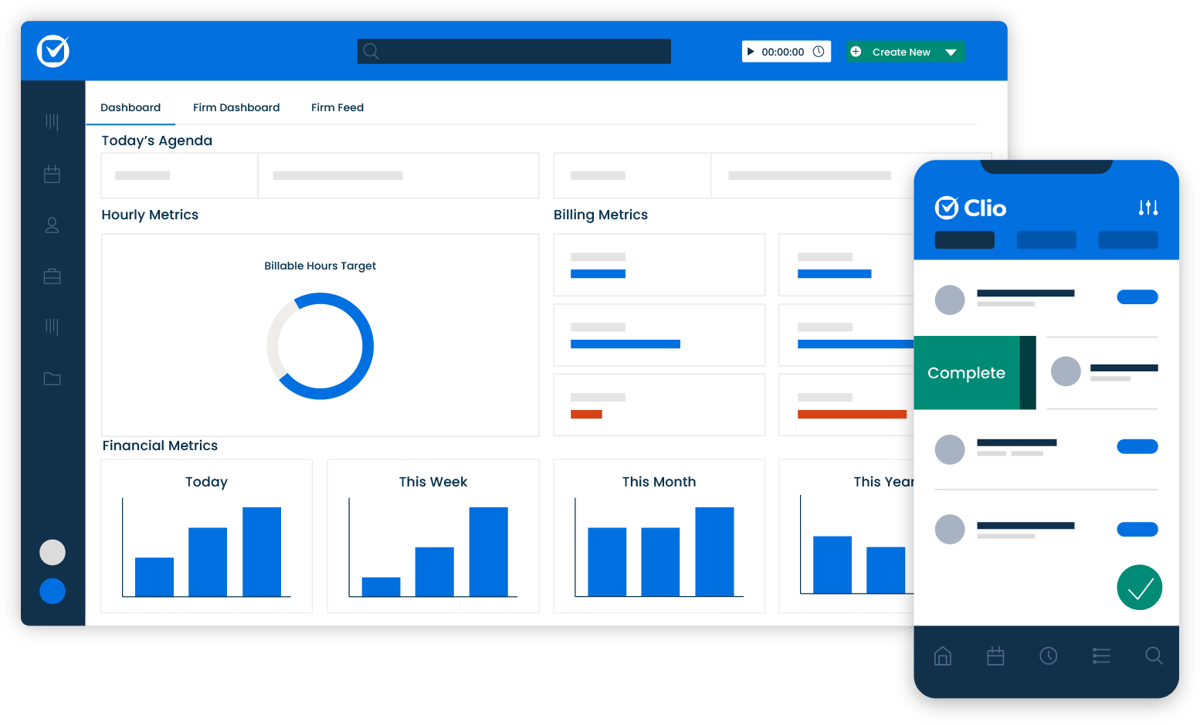
Source: G2
Its comprehensive suite is remarkably user-friendly and accessible to a broad range of professionals, regardless of their technical expertise. It includes:
- Case management: Organizes client matters, documents, and communications in one centralized platform.
- Time tracking & billing: Tracks billable hours, generates invoices, and integrates with payment processing tools.
- Document management: Stores, organizes, and shares legal documents securely with version control.
- Client intake & CRM: Streamlines client onboarding with customizable intake forms and contact management.
- Task & workflow automation: Automates routine legal workflows to improve efficiency and reduce administrative tasks.
- Secure communication: Provides encrypted messaging and client portals for confidential interactions.
- Integrations & API access: Connects with legal tech tools like QuickBooks, Microsoft 365, and Zoom.
As a cloud-based litigation platform, Clio offers the flexibility required in today’s legal environment and allows work to be conducted from virtually anywhere.
This adaptability is especially valuable given the increasing shift towards remote and flexible working arrangements.
3. Everlaw
Everlaw is a global leader in advanced discovery and litigation support solutions. Its platform is known for merging cutting-edge technology with an intuitive design to manage the complexities of legal document analysis and case preparation efficiently.
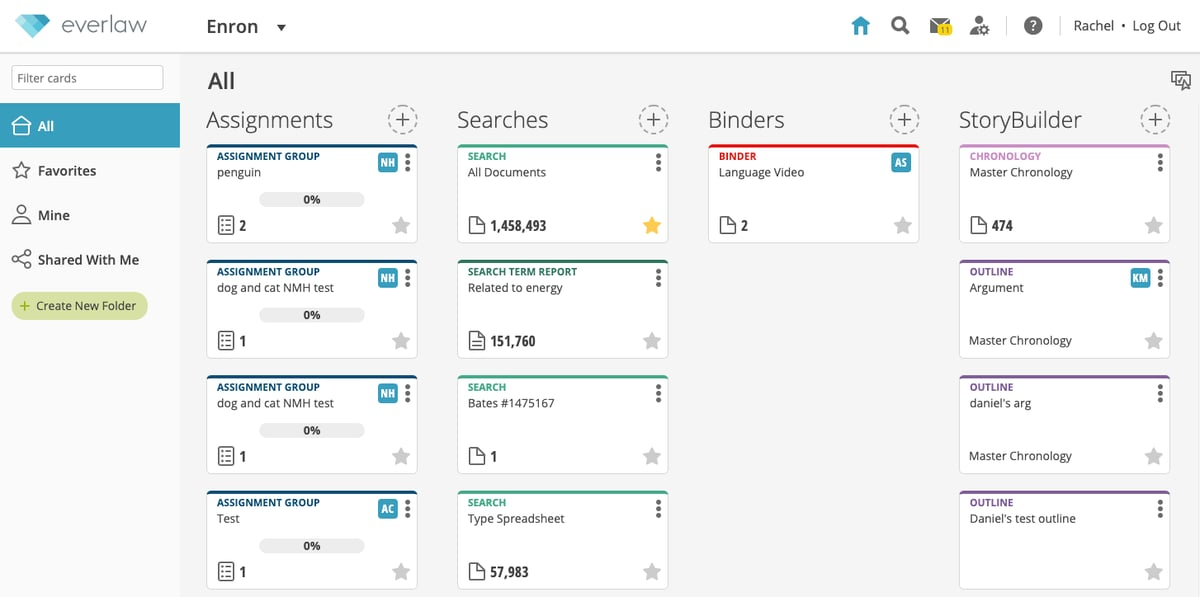
Source: G2
Its tools are designed to simplify the electronic discovery process. This includes:
- Predictive coding: Uses machine learning to prioritize and categorize documents, speeding up the review process.
- AI-powered document review: Automates document analysis, helping legal teams quickly identify relevant information.
- Advanced search and filtering: Offers powerful search capabilities with Boolean operators and AI-driven suggestions.
- Redaction and annotation tools: Allows users to highlight, redact, and comment on key information directly within documents.
- Case timeline visualization: Helps legal teams track case progress and connect key events through interactive timelines.
- Automated transcription: Converts audio and video files into searchable text for faster review.
What’s also great about Everlaw is how it champions team collaboration. The platform includes tools for annotation, tagging, and sharing documents, enabling team members to work together regardless of their physical location.
4.LawVu
LawVu combines multiple aspects of legal operations into one convenient platform. This approach is meant to address the specific needs of in-house corporate legal departments and improve the efficiency, collaboration, and overall management of legal matters.
Source: G2
The platform offers:
- Matter management: Centralizes all legal matters, documents, and communications in one platform.
- Contract lifecycle management: Tracks contracts from drafting to execution with automated workflows.
- Spend management: Monitors legal expenses, invoices, and budgets to control costs.
- Knowledge management: Stores and organizes legal documents, templates, and historical case data.
- Task & workflow automation: Streamlines legal processes with automated task assignments and approvals.
- Collaboration tools: Enables secure communication and collaboration between in-house teams and external counsel.
Plus, LawVu’s platform includes advanced analytics and reporting capabilities, which allow legal services to get a clear grasp of their operations, assess performance, and make data-driven decisions to improve their services.
5. LeanLaw
LeanLaw is a smart solution for smaller and mid-sized law firms looking to mesh their legal practice needs with solid accounting.

Source: LeanLaw.com
By teaming up with QuickBooks Online, LeanLaw taps into powerful accounting tools and makes the whole financial side of running a law firm—from keeping track of billable hours to keeping an eye on the firm’s finances—a lot smoother and more straightforward.
Here’s a look at some of its key features:
- Time tracking: Tracks billable hours with real-time timers and manual entry options.
- Automated billing & invoicing: Generates invoices with LEDES compliance and integrates with QuickBooks.
- Trust accounting: Manages client trust accounts with built-in compliance safeguards.
- Expense tracking: Logs case-related expenses and links them to client invoices.
- Revenue & compensation reports: Provides insights into firm profitability and attorney compensation.
- Matter management: Organizes cases, documents, and client information in one place.
- Client portal: Enables secure client communication and access to invoices.
LeanLaw also offers a package for organizing client details and internal resources, so everything you need is just a few clicks away.
6. Smokeball
Smokeball is legal practice management software geared specifically towards small law firms and solo practitioners. It focuses on streamlining repetitive legal processes, which can reduce the time lawyers spend on administrative work.

Source: G2
Some of its best features include:
- Case & matter management: Centralizes case files, client communications, and documents in one platform.
- Document automation: Generates legal documents quickly using customizable templates and client data.
- Task & workflow automation: Streamlines legal workflows with automated task assignments and reminders.
- Firm insights & reporting: Provides real-time analytics on firm performance, revenue, and productivity.
- Secure client communication: Offers a built-in client portal for messaging and document sharing.
Billing and time tracking are other areas where Smokeball excels. It automatically tracks the time spent on each task and integrates this with its billing system, which simplifies the invoicing process and makes sure that no billable hour goes unrecorded.
7. Ironclad
Ironclad is a complete and scalable solution for teams drowning in contracts and looking for a better way to get things done.

Source: G2
The contract management tool automates the creation, execution, and management of contracts with the following features:
- AI-powered contract review: Uses AI to analyze contracts, identify risks, and suggest edits.
- Automated contract generation: Creates contracts using templates and pre-approved clause libraries.
- E-signature integration: Integrates with DocuSign and other e-signature platforms for seamless contract execution.
- Real-time collaboration: Allows legal, sales, and procurement teams to collaborate on contracts within the platform.
- Contract repository & search: Stores all contracts in a secure, searchable database with advanced filtering.
- Compliance & audit trails: Tracks all contract changes and approvals for compliance and reporting.
In addition, this tool can integrate with other tools you’re already using. Its integration capabilities make sure that contract management becomes a cohesive part of the broader business ecosystem and leads to smoother workflows across departments.
8. MyCase
MyCase is a legal practice management software that simplifies legal workflows and keeps them running smoothly. It tackles everything from case management and client communications to billing and time tracking into one neat platform.
Source: G2
This means lawyers can spend less time juggling different tools and more time focusing on their clients’ needs.
With MyCase, everything you need to run your law practice is right there in one easy-to-use interface. Its core features include:
- Case management: Organizes case details, deadlines, and documents in a centralized system.
- Document automation: Creates, stores, and manages legal documents with customizable templates.
- Time tracking & billing: Logs billable hours, generates invoices, and integrates with online payment processing.
- Secure client messaging: Provides a built-in client portal for encrypted communication and case updates.
- Task & calendar management: Schedules meetings, tracks deadlines, and assigns tasks to team members.
- Online payment processing: Allows clients to pay invoices easily through credit cards or ACH transfers.
- Reporting & analytics: Offers insights into firm performance, revenue, and case progress.
- Mobile access: Enables lawyers to manage cases and communicate with clients on the go.
MyCase is also great when it comes to keeping clients in the loop. It offers secure messaging, updates on case progress, and easy online payment options, which helps law firms improve their client relationships.
9. CoCounsel
CoCounsel, powered by Casetext, is another innovative legal tech tool. This AI-driven assistant is groundbreaking for several reasons, notably, its ability to offer legal support across a range of tasks that traditionally require hours of human effort.

Source: Thomsonreuters.com
It is designed to understand and execute a variety of legal tasks like:
- AI-powered legal research: Uses advanced AI to quickly find relevant case law, statutes, and legal precedents.
- Automated contract review: Analyzes contracts, flags risks, and suggests revisions to ensure compliance.
- Deposition preparation: Summarizes depositions, highlights key testimony, and extracts important details.
- Litigation strategy assistance: Provides AI-driven insights to help lawyers craft stronger legal arguments.
- Legal document analysis: Reviews legal documents for inconsistencies, missing clauses, and potential errors.
- Secure cloud-based storage: Keeps all legal research, documents, and case materials organized and accessible from anywhere.
- Real-time collaboration: Enables legal teams to work together on case analysis, research, and document review.
- Integration with legal tools: Connects with existing case management and document automation software.
Powered by Casetext’s extensive legal database, it leverages the latest in AI legal technology to fine-tune its capabilities and offer more personalized and accurate assistance over time. Plus, they offer rapid response services for global operations.
10. UniCourt
UniCourt is a legal tech service that simplifies how law firms get their hands on and use legal data. It’s a go-to resource for law firms, businesses, and anyone who needs quick access to court records and insights into legal trends.
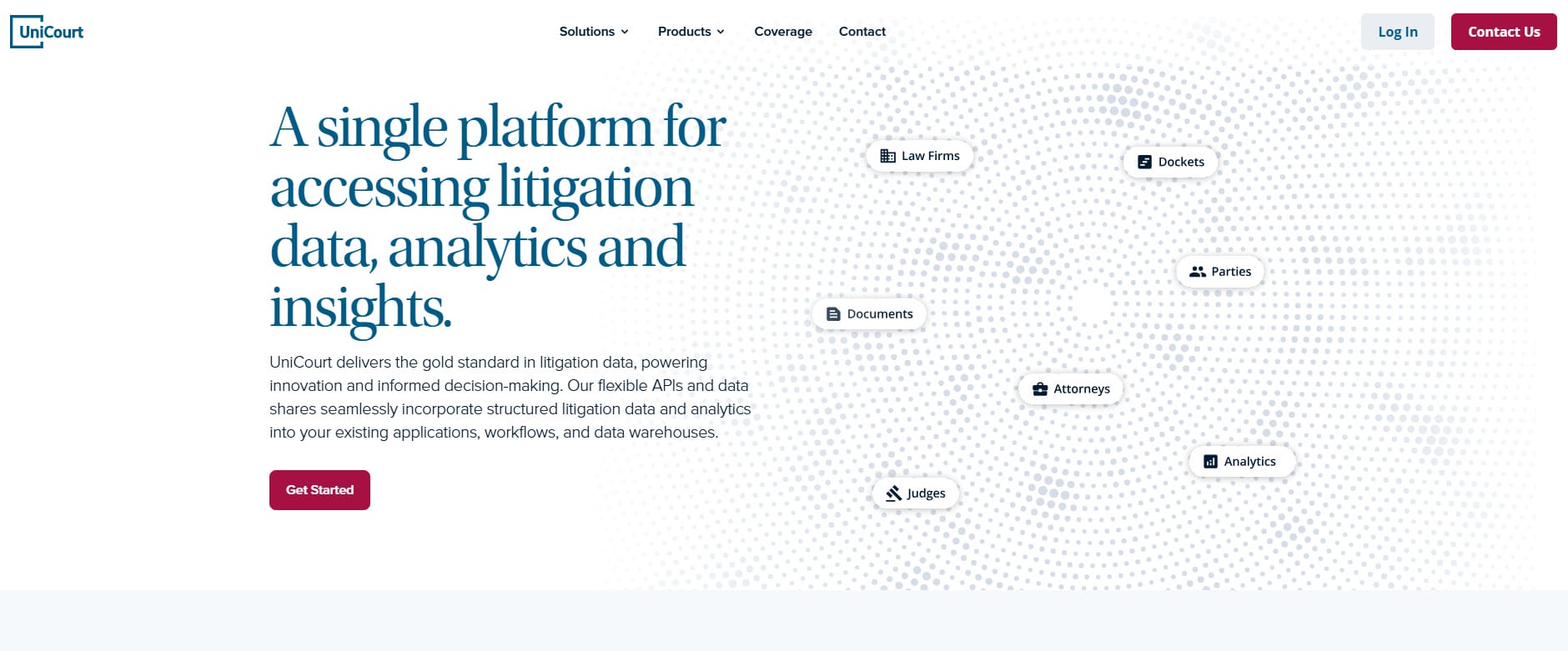
Source: UniCourt.com
The best feature of UniCourt is how it brings all kinds of legal data together under one roof. Whether you’re keeping tabs on a specific case, digging into legal precedents, or trying to spot trends in litigation, UniCourt lets you do it all without the need to jump between different databases.
Here are some of its key features:
- Automated court data access: Retrieves real-time case data from federal and state courts.
- Legal research & analytics: Provides AI-driven insights into case law, dockets, and litigation trends.
- Case tracking & alerts: Notifies users of case updates, filings, and procedural changes.
- API & data integration: Connects court records with legal and business intelligence platforms.
- Docket management: Centralizes court dockets for easy organization and access.
- Business & litigation intelligence: Identifies patterns in litigation, helping firms assess risks and opportunities.
- Document retrieval: Automates access to pleadings, motions, and other legal filings.
Aside from accessing data, UniCourt helps you manage it better. You can set up alerts to track cases automatically, so you’re always in the loop with real-time updates without constantly checking in manually.
Automate Discovery Drafting with Briefpoint.ai
Artificial intelligence is designed to eliminate the most tedious legal workflows. So, why not start with the most time-consuming tasks?
Briefpoint simplifies the process, cutting hours of manual work down to just minutes. With AI-powered automation, smart objections, and seamless client input collection through Briefpoint Bridge, your legal team can work faster and more efficiently—without sacrificing accuracy.
Stop spending valuable time on repetitive tasks. Try Briefpoint today and see how much time and money you can save. Schedule a demo now!
The Best Legal Technology Company for Discovery Documents
Discovery responses cost firms $23,240, per year, per attorney. $23,240 estimate assumes an associate attorney salary of $150,000 (including benefits – or $83 an hour), 20 cases per year/per associate, 4 discovery sets per case, 30 questions per set, 3.5 hours spent responding to each set, and 1800 hours of billable hours per year.
Book a demo and save on these costs with Briefpoint.
FAQs About Legal Service Providers
What is legal tech, and how does it benefit legal professionals and their clients?
Legal tech refers to the use of technology and software to provide legal services and support the operation of law firms and legal departments. Legal tech benefits legal professionals by streamlining workflows, reducing the time and cost associated with traditional legal processes, and enhancing the accuracy of legal documents and research.
For clients, legal tech can lead to quicker resolutions of legal matters, improved access to legal services, and, often, lower costs.
Can legal tech replace lawyers?
While legal tech software improves the efficiency and effectiveness of legal services, it is not designed to replace lawyers. Instead, it serves as a tool to assist lawyers in their work.
Technology can automate repetitive tasks and manage large volumes of data, but the nuanced judgment, ethical considerations, and client advocacy provided by human lawyers are beyond its current capabilities.
How is AI being used in legal tech, and what are its limitations?
AI in the legal industry is primarily used for automating document analysis, conducting legal research, predicting legal outcomes, and improving client service through chatbots and other interactive tools. It can sift through vast amounts of legal data to identify patterns, suggest relevant case law, and even draft legal documents.
How can legal drafting software benefit an international law firm?
Legal drafting software streamlines corporate and transactional issues by automating contract creation, compliance filings, and other essential documents. This reduces manual effort, ensures consistency across jurisdictions, and improves efficiency—ultimately freeing internal resources for higher-value legal work.
The information provided on this website does not, and is not intended to, constitute legal advice; instead, all information, content, and materials available on this site are for general informational purposes only. Information on this website may not constitute the most up-to-date legal or other information.
This website contains links to other third-party websites. Such links are only for the convenience of the reader, user or browser. Readers of this website should contact their attorney to obtain advice with respect to any particular legal matter. No reader, user, or browser of this site should act or refrain from acting on the basis of information on this site without first seeking legal advice from counsel in the relevant jurisdiction. Only your individual attorney can provide assurances that the information contained herein – and your interpretation of it – is applicable or appropriate to your particular situation. Use of, and access to, this website or any of the links or resources contained within the site do not create an attorney-client relationship between the reader, user, or browser and website authors, contributors, contributing law firms, or committee members and their respective employers.
What is Legal Drafting Software and Why Do You Need It?
What is Legal Drafting Software and Why Do You Need It?
Drafting legal documents is an inescapable part of litigation. However, as important as this process is, it’s undoubtedly an obstacle.
What if you could draft documents with the same⎯if not higher⎯level of accuracy, quality, and consistency as manual drafting?
Let’s talk about legal drafting software, what it is, and how it can benefit both you and your clients.

What is Legal Drafting Software?
Legal drafting software is a tool that helps lawyers and legal professionals create various legal documents at least ten times faster than the manual process.
By using advanced technologies like artificial intelligence (AI) and machine learning, these tools automate many parts of the drafting process.
With legal document generation software, you can easily create a wide range of documents, including but not limited to:
- Discovery responses
- Estate planning documents
- Contracts
- Pleadings
- Real estate documents
- Intellectual property documents
- Power of attorney forms
- Litigation briefs
- Corporate legal documents
- Immigration forms
Most of these tools come with smart features like template libraries, clause banks, and automated formatting.
While specific functionalities or niches can vary among these tools, the goal remains the same: to help legal professionals draft their documents in just a few clicks.
The Benefits of Automated Legal Document Drafting
From the definition alone, it’s easy to see how drafting software can be incredibly beneficial for a law firm. Still, we should take a look at the specific advantages to see if it’s a worthy investment for you.
1. Automation Software Saves You Loads of Time
Imagine slashing hours off your workload and achieving better productivity by simply automating the drafting process, which is exactly what legal drafting software offers.
Instead of creating documents from scratch and spending hours on each one, you can start with automated templates designed for various legal documents.
These templates come preloaded with standard clauses and language to simplify the creation process. The software can also automatically pull relevant information from your databases or previous documents, which reduces the need for repetitive data entry.
Aside from speeding up routine drafting and template building, automation also increases your efficiency by allowing you to manage more cases in less time.
It’s a huge burden off lawyers and paralegals, and let’s not forget a non-direct but equally as beneficial effect: better time management for attorneys.
2. Your Documents Are More Accurate and Consistent
Accuracy and consistency are non-negotiables for any legal document, especially one related to litigation.
Consistency and accuracy in litigation documents keep everything clear and professional, which helps you avoid misunderstandings, lower risk, and make sure your arguments come across as strong and credible.
So, legal drafting software helps you tick off these boxes by using standardized language and terminology across all your documents. Automated formatting takes care of applying the correct styles for a polished, professional look every time.
Many legal drafting tools also offer document versions, which help you manage changes made to each file over time.
What’s more is that advanced generative AI capabilities can detect and suggest corrections for grammatical errors, legal discrepancies, and inconsistencies within the document—all costly errors that can disrupt your legal workflows.
This means you can produce error-free documents that uphold your professional standards every single time.

3. You’ll Save Time and Money While Improving Your Legal Services
The financial benefits of legal drafting software are hard to overlook. By automating the drafting process, you can handle a greater volume of cases without adding to your workload—which, at the very least—can increase law firm profitability.
More importantly, better efficiency translates to lower operational costs, as there’s less need for manual labor and fewer staffing requirements.
Additionally, with fewer errors and inconsistencies, you’ll spend less time on revisions and corrections and save valuable time and resources. In a nutshell, legal drafting software lets you do more with less, making it a cost-effective solution for any legal practice.
How Does Briefpoint Work?
Sometimes, we’re so used to doing a task that we don’t notice how time-consuming it is. Take generating documents for discovery as an example.

If you’ve been doing it manually for years, you’ve likely made your schedule accommodate the process instead of the other way around.
But what if you can start creating these simple yet tedious documents in minutes? What if you can use that precious time for more important aspects of litigation?
The Briefpoint Process
These are the solutions that Briefpoint.ai wants you to achieve. Here’s how it works:
- Upload your opposing counsel’s discovery request: Briefpoint’s machine-learning AI system will start extracting as much information as possible, such as routine stuff like court names, case numbers, parties involved, and so on.
- Add objections and responses: At this point, Briefpoint will have already created a caption and filled out the necessary information in your draft. Briefpoint automatically adds objections to each request or interrogatory you can select from.
- Download to Microsoft Word: You can download and edit your draft on MS Word at any point in the process. What you get is a mostly completed, properly formatted document in mere minutes!
Taking too much time collecting client responses? Briefpoint Bridge is a built-in feature that lets you select all the interrogatories that need your client’s input, translate the questions into plain English, and send an email link where your client can input their answers.
After your client finishes the form, Bridge will let you input and edit those responses into your document. No more of that endless back-and-forth!
Leave the Tediousness of Discovery Documents Behind
Drafting discovery responses is a time drain, but it certainly doesn’t have to be. Briefpoint takes the hassle out of the process, cutting down hours of work into just minutes.
That means fewer headaches, fewer errors, and more time to focus on what actually moves the needle in your cases.
Why keep doing things the hard way? Try Briefpoint for yourself and see how much time you can save. Book a demo today and take the stress out of legal drafting.
Here’s How Briefpoint Can Save You Thousands
Discovery responses cost firms $23,240, per year, per attorney. $23,240 estimate assumes an associate attorney salary of $150,000 (including benefits – or $83 an hour), 20 cases per year/per associate, 4 discovery sets per case, 30 questions per set, 3.5 hours spent responding to each set, and 1800 hours of billable hours per year.
Book a demo and save on these costs with Briefpoint.
FAQs About Legal Document Automation
What software is used to write legal documents?
Legal teams use software like Briefpoint to optimize the document creation process. These tools offer templates, conditional logic, automation features, and AI-powered assistance to speed up the drafting process while ensuring accuracy and compliance.
What is the best legal research software?
The best legal research software depends on your needs. Westlaw and LexisNexis are industry leaders, offering comprehensive legal databases and AI-powered search capabilities. Other notable options include Fastcase, Casetext, and Bloomberg Law, which pull data quickly and provide cost-effective and AI-enhanced research solutions.
How do I draft a legal document?
To draft a legal document, start by identifying the type of document you need and gathering all relevant details. Use a legal drafting tool or template creation tool to ensure proper formatting and terminology. Many legal drafting software solutions, like Briefpoint, offer AI-driven automation to streamline this process. Always review documents for accuracy and compliance before use.
How much does legal billing software cost?
Legal billing software pricing varies based on features and firm size. Entry-level options start at around $20 per user per month, while more advanced platforms like Clio Manage and TimeSolv can range from $40 to $100 per user per month. Some software solutions offer tiered pricing based on the number of users and additional features like trust accounting and seamless integration.
The information provided on this website does not, and is not intended to, constitute legal advice; instead, all information, content, and materials available on this site are for general informational purposes only. Information on this website may not constitute the most up-to-date legal or other information.
This website contains links to other third-party websites. Such links are only for the convenience of the reader, user or browser. Readers of this website should contact their attorney to obtain advice with respect to any particular legal matter. No reader, user, or browser of this site should act or refrain from acting on the basis of information on this site without first seeking legal advice from counsel in the relevant jurisdiction. Only your individual attorney can provide assurances that the information contained herein – and your interpretation of it – is applicable or appropriate to your particular situation. Use of, and access to, this website or any of the links or resources contained within the site do not create an attorney-client relationship between the reader, user, or browser and website authors, contributors, contributing law firms, or committee members and their respective employers.
5 Best Legal Tech For Litigation (2025’s Top Options)
5 Best Legal Tech For Litigation (2025's Top Options)
Many legal professionals will agree that litigation is one of the most difficult practice areas to find success in, whether it’s civil or criminal. It’s also worth noting that there’s so much at stake with litigation, including money, your client’s fate, and the law firm’s reputation.
But if there’s one thing successful lawyers will agree on, it’s that every law firm needs to adapt to technology as it changes.
In this guide, we will be going into one of the most important fields of legal tech: litigation tools. Discover the types of legal tech tools for litigation, the benefits of using such products, and how you can integrate them into your practice to serve clients even better.

Types of Legal Technologies for Litigation
The legal tech industry solves hundreds of problems for law firms, which span across multiple aspects of the legal profession, including litigation.
Here are types of legal tech that are particularly useful for law firms that focus on litigation, as well as arbitration or mediation:
- Discovery document generation: AI-powered tools like Briefpoint.ai automate discovery request and response drafting, which mostly eliminates the need for manual document creation and reduces hours of work to minutes.
- Case management software: Centralizes case files, deadlines, communications, and tasks to help litigation teams stay organized and make sure nothing is overlooked.
- Legal research platforms: AI-driven databases streamline legal research, offering quick access to case law, statutes, regulations, and predictive insights.
- Communication and collaboration tools: Secure messaging, video conferencing, and collaboration features make way for seamless interaction among legal teams, clients, and stakeholders.
- Trial presentation software: Supports real-time display of evidence, including documents, videos, and audio, to help attorneys present compelling arguments in court.
- Litigation analytics: Analyzes past rulings, judge decisions, and litigation trends to provide data-driven insights that strengthen case strategy.
How Can Legal Tech Help Litigation?
The legal industry is becoming more and more accepting of technology as it continues to evolve–and for all the right reasons. From a wider point of view, legal technology makes workflows easier, faster, and overall more efficient.
But if we look closer, the benefits of legal technology for litigation are clearer:
Maximizing Operational Efficiency
Legal technology introduces automation in various facets of litigation, including document management, billing, and case tracking.
This automation reduces the time legal professionals spend on administrative tasks, which allows them to allocate more resources toward critical thinking and case strategy development.
The result? Law firms and legal departments can handle cases more effectively, reduce delays, and improve the overall quality of their legal services.
Improving Accuracy and Risk Mitigation
Legal tech tools minimize the potential for human error by reducing the reliance on manual processes.
Automated document generation, for example, helps maintain consistency and accuracy in legal filings. In turn, this reduces the risk of mistakes that could lead to delays or negative legal outcomes.
Plus, litigation analytics can help identify potential risks and outcomes based on historical data, which allows for better-informed decision-making.
Refining Discovery and Evidence Management
Automated discovery tools are designed to handle vast amounts of electronic data and allow legal teams to efficiently identify, collect, and analyze relevant information.
This feature is an absolute must in a digital age where evidence often resides in electronic formats. Advanced search algorithms and analytics can uncover crucial pieces of evidence that might be overlooked manually, which can offer a strategic advantage in litigation.
Reducing Costs
While the initial investment in legal tech may be significant, the long-term savings are substantial. Law firms can reduce overhead costs just by simply automating routine tasks and improving efficiency.
Additionally, the precision and speed of legal tech tools can decrease the duration of litigation, which further cuts down expenses that often come with prolonged or delayed cases.
Upgrading Client Satisfaction
When you consider the benefits of legal technology, you can see that using legal technology contributes to higher levels of client satisfaction.
Clients benefit from quicker responses, more transparent communication, and potentially faster resolutions to their cases. More importantly, the ability to provide detailed insights and data-driven strategies can reinforce clients’ confidence in their legal representation.
Increasing Law Firm Profitability
Positive case outcomes almost always result in better law firm profitability, and that’s what both lawyers and clients want. Software solutions can increase the chances of a positive verdict via better legal research, stronger evidence, or even the absence of errors.
In turn, lawyers get their win, and happy clients are likely to bring in more potential clients to the law firm through word-of-mouth. Either way, the winning law firm will see a positive effect on their bottom line.
Best Legal Tech Litigation Tools Every Law Firm Should Have
While legal tech, in general, can yield positive results for a law firm, not all legal tech products are made equal. Legal practitioners still have to be selective when choosing the right stack of tools, especially when it comes to something as crucial as litigation.
Here’s a list of some of the best litigation tools to help you narrow down your search:
1. Briefpoint.ai
Briefpoint.ai is a discovery document automation tool that helps legal professionals generate responses and outgoing sets for Requests for Production, Requests for Admission, and Interrogatories.

Instead of manually drafting discovery documents—a process that can take hours or even days—Briefpoint’s AI-powered system simplifies the workflow, reducing effort while maintaining accuracy.
With a simple three-step process, users can upload a discovery request, select objections and responses, and generate a formatted document that’s ready to finalize in Word.
It’s designed to cut down on repetitive tasks, improve efficiency, and minimize errors in discovery document preparation.
Best Features
- Automated discovery responses: Uses AI to extract details from discovery requests and generate responses in minutes.
- Built-in formatting compliance: Identifies court names and applies local formatting rules automatically.
- Smart objection selection: Lets users choose from pre-set objections, which makes it incredibly easier to respond to requests efficiently.
- Word document export: Provides a structured, mostly completed document that can be finalized in Word.
- Briefpoint Bridge: Helps you translate interrogatories into plain English, collect responses from clients, and plug in their answers into your legal documents.
Pros
- Saves significant time on discovery document preparation
- Reduces manual data entry and copy-pasting
- Ensures proper formatting based on court requirements
- AI-assisted response generation minimizes errors
- Intuitive interface with minimal learning curve
- Allows document downloads at any stage of the process
2. Clio
Clio is always going to be the go-to for case and practice management. It offers features that cover everything from document management and time tracking to billing and client communication.

Source: G2
Plus, everything is on a cloud-based system, which allows easy access to case files and information from anywhere.
Best Features
- Case and document management: Stores case files, emails, and client communications in a centralized platform.
- Billing and invoicing: Automates time tracking, invoice creation, and online payments to simplify financial management.
- Client intake and CRM tools: Helps law firms manage leads, onboard clients, and maintain relationships.
- Cloud-based access: Enables remote work with secure access from any device.
- Extensive integrations – Connects with legal research tools, accounting software, and other third-party applications.
Pros
- Comprehensive case and client management features
- User-friendly interface with easy navigation
- Secure cloud storage with access from anywhere
- Customizable workflows and task automation
Cons
- Higher pricing compared to some alternatives
- Learning curve for advanced features
- Some features may require third-party integrations for full functionality
3. Lex Machina
Lex Machina is known for transforming raw legal data into strategic insights. This platform mines litigation data from a vast array of sources and applies sophisticated analytics to unearth patterns and trends that are not immediately apparent.
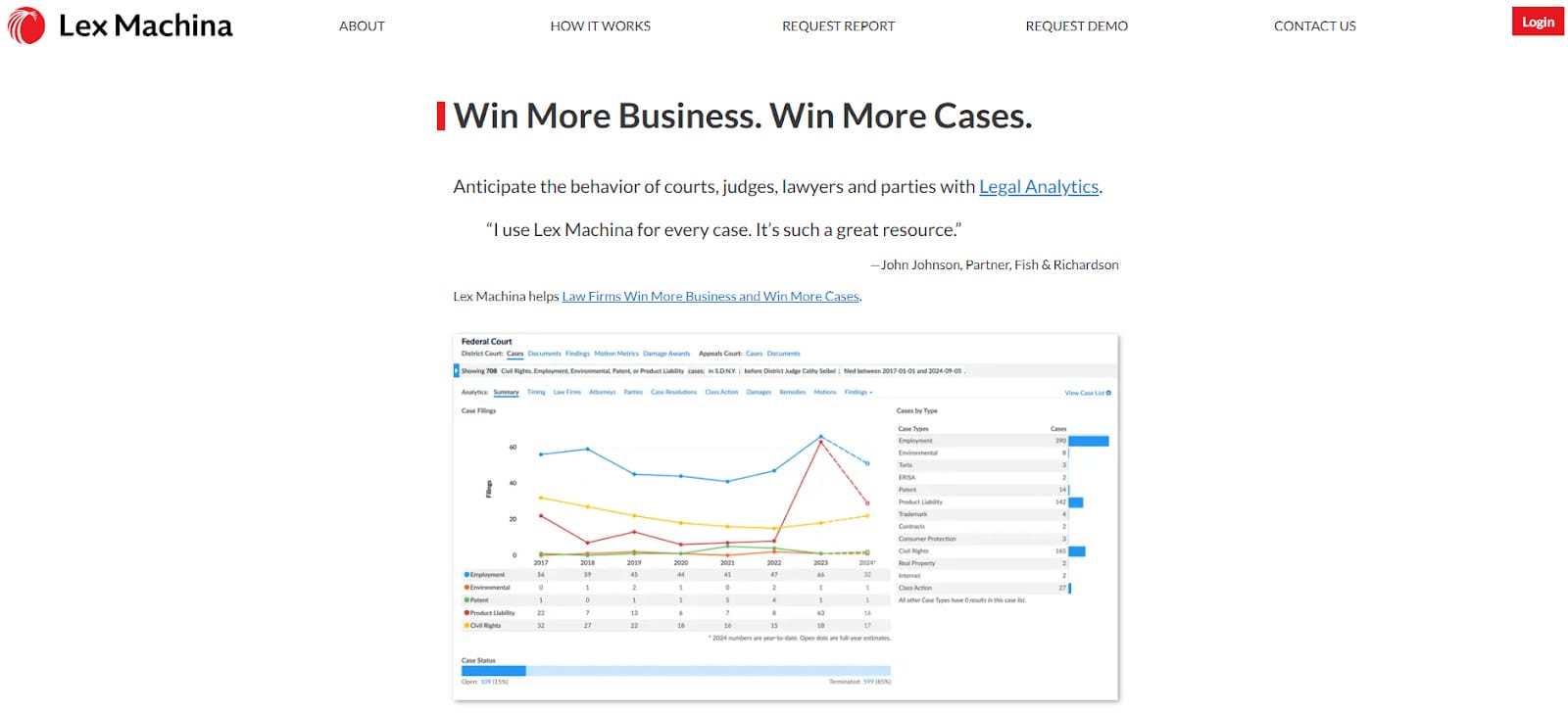
Source: LexMachina.com
By offering a detailed examination of judges’ rulings, litigation histories, and even the tactics employed by opposing counsel, Lex Machina gives legal professionals a deeper understanding of the legal battlefield.
Best Features
- Judge and court analytics: Tracks judge tendencies, ruling patterns, and case outcomes.
- Opposing counsel insights: Analyzes law firms and attorneys to predict litigation strategies.
- Case outcome predictions: Uses historical data to estimate the likelihood of success.
- Practice area-specific data: Provides tailored analytics for different legal specialties.
- Customizable reports: Generates visual reports for presentations and case evaluations.
Pros
- Saves time on legal research with automated data analysis
- Provides transparency on judge and attorney behavior
- Covers a wide range of practice areas
- User-friendly dashboards with clear visualizations
Cons
- Expensive compared to standard legal research tools
- Requires training to maximize its features
- Data is limited to available court records
4. MyCase
MyCase bridges the communication gap between lawyers and their clients and fosters an environment of trust and transparency.

Source: G2
One of the standout features of MyCase is the ability for clients to have real-time access to their case files and information. This means that at any moment, they can log in to the portal to review documents, see the latest updates, and track the progress of their case.
Such access demystifies the legal process for clients and helps them feel more involved and informed about the proceedings of their cases.
Best Features
- Case and document management: Organizes case files, emails, and client records in a single dashboard.
- Built-in billing and payments: Supports online payments, time tracking, and automated invoicing.
- Client communication portal: Provides a secure space for messaging, document sharing, and updates.
- Task and workflow automation: Helps organize and speed up repetitive administrative tasks.
- Mobile app: Allows attorneys to manage cases and communicate with clients on the go.
Pros
- Intuitive and user-friendly interface
- Secure cloud-based access from any device
- Integrated payment processing with online billing
- Organizes client communication with a dedicated portal
Cons
- Limited customization for reports and workflows
- Some integrations require additional setup
- Mobile app has fewer features than the desktop version
5. LawPay
LawPay is a legal payment processing platform designed to help law firms securely accept online payments while staying compliant with ABA and IOLTA regulations.
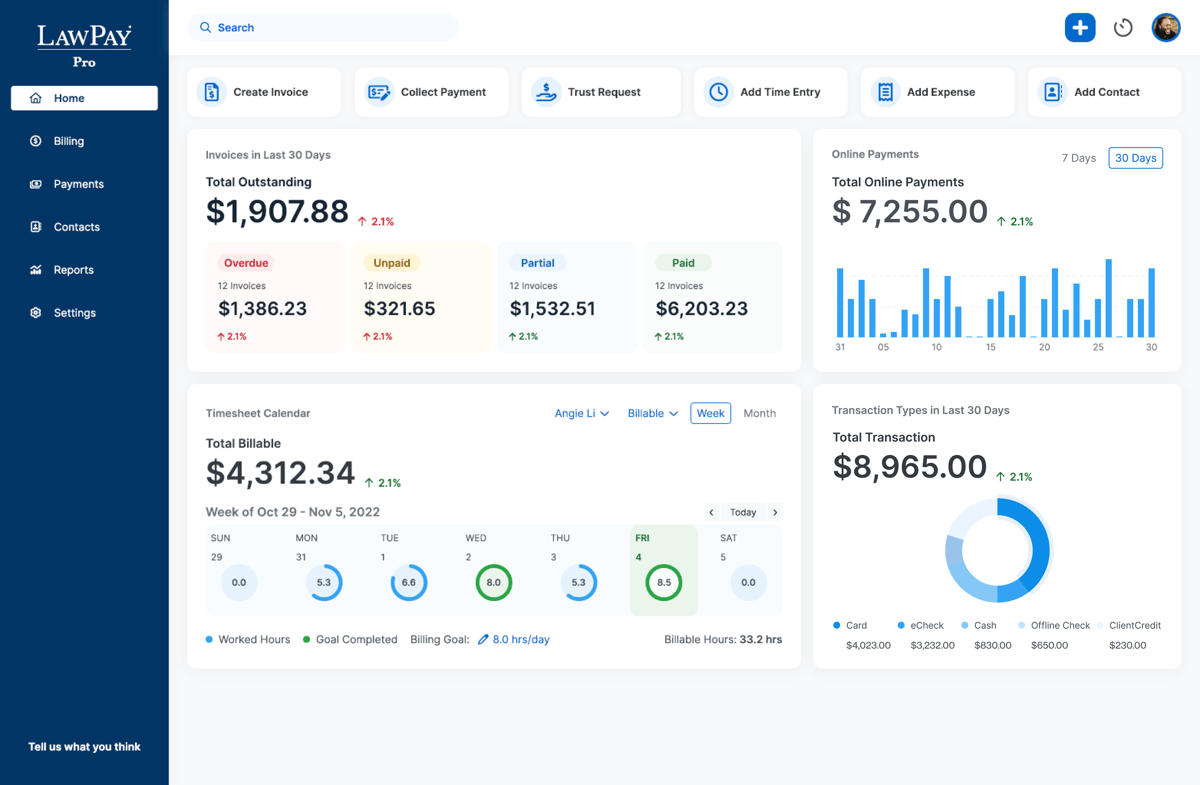
Source: G2
For litigation lawyers, it simplifies tracking billable hours by integrating with time-tracking and invoicing tools. Ultimately, it helps maintain accurate client billing.
Best Features
- Trust accounting compliance: Keeps client funds separate and ensures IOLTA and ABA compliance.
- Multiple payment options: Accepts credit cards, debit cards, and eChecks.
- Secure online payments: Provides a client-facing payment portal for easy transactions.
- Integration with legal software: Connects with Clio, MyCase, and other practice management tools.
- Recurring and scheduled payments: Automates billing for retainers and ongoing client payments.
Pros
- Helps litigation lawyers track all billable hours efficiently
- Maintains trust accounting compliance
- Easy-to-use client payment portal
- Integrates with major legal management platforms
Cons
- Processing fees may be higher than general payment processors
- Limited features beyond payment processing
- No built-in invoicing (relies on integrations)
Best Practices for Using Legal Technology
Implementing litigation technology effectively goes beyond selecting the right tools; to truly enhance the practice of law, you also need a strategic approach to integration, usage, and ongoing management.
Here are some best practices for law firms looking to make the most of legal technology:
Prioritize Training and Education
Just having the right legal tech isn’t enough—everyone on your team needs to know how to use it effectively. A solid training plan helps legal professionals get up to speed quickly so they’re not wasting time figuring things out on their own.
Start with a structured onboarding process that walks users through essential features and workflows. But don’t stop there—ongoing education is just as important. For example, you can:
- Host live training sessions
- Provide on-demand tutorials
- Set up refresher courses
- Create a knowledge base
- Encourage peer learning
The more comfortable they are with the tools, the more efficiently they can get work done.
Implement Strong Security Measures
Law firms handle sensitive client data every day, so security has to be a top priority. Encryption keeps documents and communications safe, while regular software updates help close security gaps that hackers might exploit.
It’s also a good idea to run periodic security audits to catch vulnerabilities before they become a problem. Adding multi-factor authentication (MFA) and role-based access controls can further limit who gets access to what.
Security isn’t a one-and-done task—ongoing training helps staff spot phishing attempts, use secure networks, and follow cybersecurity best practices.
Focus on Client Data Protection
Keeping client data safe is non-negotiable in legal practice. That means using encrypted emails, secure client portals, and other protected channels instead of standard messaging apps.
Staff should also be trained on confidentiality protocols to prevent accidental data leaks. And when adopting new legal tech, make sure it meets security standards like GDPR or ABA guidelines.
Regular data backups and a solid disaster recovery plan help make sure client information stays protected, even if a cyberattack or system failure occurs.
Embrace Flexibility and Scalability
Legal technology is always evolving, so law firms need tools that can grow with them. Choosing flexible and scalable solutions makes sure that as needs change—whether due to firm expansion, new regulations, or emerging tech—there’s no disruption to daily operations.
Cloud-based and modular platforms make it easier to integrate new features without overhauling existing systems. It’s also worth keeping up with legal tech news to find new opportunities to upgrade your litigation workflows.
Optimize for Collaboration and Accessibility
Legal work often requires teamwork, and the right technology should make that easier, not harder. Cloud-based tools allow staff to access case files, documents, and communications from anywhere, whether they’re in court, at the office, or working remotely.
Cross-device compatibility provides a seamless experience, keeping lawyers, paralegals, and clients connected and productive no matter where they are
Monitor and Analyze Technology Performance
Investing in legal technology is only worth it if it actually improves efficiency. Firms should routinely track how these tools impact productivity, case outcomes, and overall workflow.
Regular assessments help determine whether a tool is meeting expectations or if adjustments—such as training, upgrades, or replacements—are needed to maximize its value.
Incorporating Technology in Your Practice Doesn’t Have to Be Difficult
The legal world is always rife with competition, and that won’t change any time soon. Stay ahead of your competitors by integrating new systems into your practice areas, starting with automation tools that can make work easier.
Use the power of artificial intelligence to get rid of the bottlenecks in litigation. With Briefpoint, you can take out hours upon hours of work spent on just drafting discovery documents. Save your brain power for more value-adding tasks and let Briefpoint do the work.
Automate Your Discovery Phase With Briefpoint
Discovery responses cost firms $23,240, per year, per attorney. $23,240 estimate assumes an associate attorney salary of $150,000 (including benefits – or $83 an hour), 20 cases per year/per associate, 4 discovery sets per case, 30 questions per set, 3.5 hours spent responding to each set, and 1800 hours of billable hours per year.
Book a demo and save on these costs with Briefpoint.
FAQs About About Legal Tech for Litigation
Will legal tech replace legal professionals?
Legal technology is designed to augment the capabilities of legal professionals, not replace them. It takes over repetitive and time-consuming tasks, freeing up lawyers to focus on more complex, strategic aspects of their cases that require human judgment, empathy, and ethical considerations.
Is legal tech expensive?
The cost of legal tech varies widely depending on the solution, ranging from affordable subscriptions for basic tools to significant investments for comprehensive platforms. However, focusing solely on the upfront cost misses the bigger picture. Legal tech should be viewed as an investment that can lead to substantial savings and efficiency gains in the long run.
Can small law firms benefit from using legal tech?
Absolutely, and in many ways, legal tech can be a game-changer for small firms. While smaller practices may lack the extensive resources of larger firms, legal technology levels the playing field, allowing them to compete more effectively. For small firms, efficiency and the ability to provide personalized service are crucial competitive advantages.
The information provided on this website does not, and is not intended to, constitute legal advice; instead, all information, content, and materials available on this site are for general informational purposes only. Information on this website may not constitute the most up-to-date legal or other information.
This website contains links to other third-party websites. Such links are only for the convenience of the reader, user or browser. Readers of this website should contact their attorney to obtain advice with respect to any particular legal matter. No reader, user, or browser of this site should act or refrain from acting on the basis of information on this site without first seeking legal advice from counsel in the relevant jurisdiction. Only your individual attorney can provide assurances that the information contained herein – and your interpretation of it – is applicable or appropriate to your particular situation. Use of, and access to, this website or any of the links or resources contained within the site do not create an attorney-client relationship between the reader, user, or browser and website authors, contributors, contributing law firms, or committee members and their respective employers.
How to Automate Legal Discovery in 2025 (Using AI)
How to Automate Legal Discovery in 2025 (Using AI)
Estimates suggest that lawyers only bill 2.3 hours during an 8-hour workday. What happens to the rest of your time?
Unfortunately, much of it goes on paperwork, such as legal discovery. Legal professionals spend vast tracts of their office hours performing non-billable tasks, reducing their earning power and risking burnout.
This has sparked a growing interest in automating legal discovery processes.
Law firms and individual attorneys want to save time and money by getting sophisticated software to streamline this workflow.
Such technology now exists. For example, Briefpoint’s discovery document drafting software can save an estimated 87% of the time needed to create a response. Plus, these new tools don’t require sophisticated technical skills.
In this article, we’ll explore how to automate legal discovery responses in your law firm.
Once you learn how to do this, you can save time and money and avoid spending hours of your day on dull, non-billable tasks!

How to Automate Legal Discovery Responses
Automating legal discovery responses involves choosing appropriate software from the many options available on the market. The solution you select will determine how much you can reduce labor and increase your billable hours.
The following is a step-by-step guide to how the most advanced AI-powered software automates legal discovery responses.
These products balance the need to speed up work against the requirement for legal accuracy and compliance.
1. Analyze the Discovery Request
Discovery response automation tools first analyze the discovery request from the opposing party. Sophisticated AI systems analyze text and extract relevant pieces of information to create a response shell.
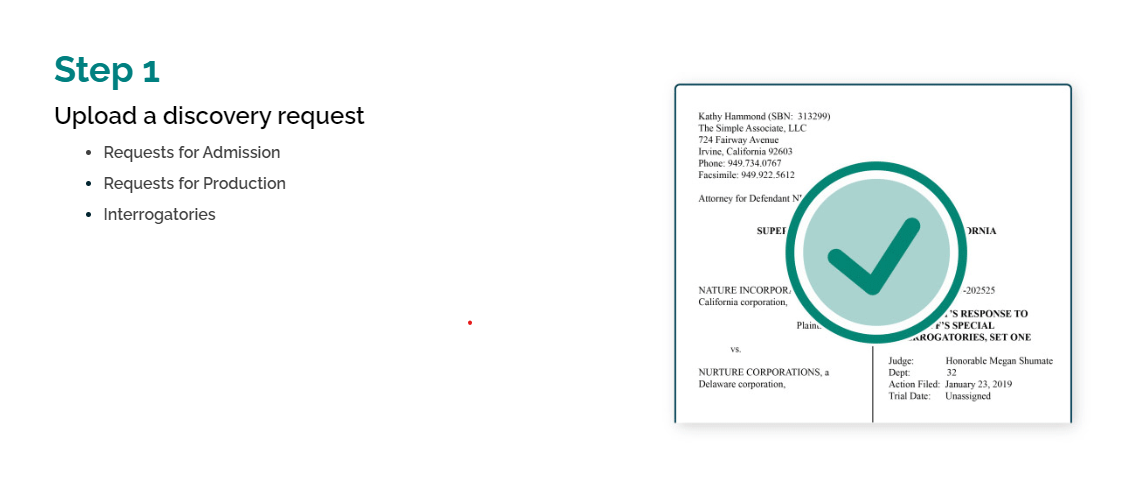
For example, Briefpoint uses machine learning and natural language processing (NLP) to transform requests for information from the opposing counsel into digestible lists.
This feature lets you see their demands in a pithy, easy-to-interpret format to speed up response. (Briefpoint can interpret requests in formats accepted in all fifty states).
2. Respond
AI tools next use AI to help you respond faster to legal discovery requests. Tools use a variety of templates and libraries to insert language that is legally permissible and in your client’s best interest.
For example, Briefpoint provides two ways to automate this process. The first is to click relevant responses from the menu on the left-hand side. Selecting an objection will cause that response to appear in the text in reply to the request.
However, you can also get the software to suggest objections for you (and why they apply to the request).
Using this method will highlight anything the solution thinks is relevant, given the inputted text. Then, you can quickly review them and edit them where appropriate.
Finally, you can use these tools to add a substantive response. This automated piece of text provides additional context for your reply.

Briefpoint also has a built-in feature called Bridge, which automates the process of collecting client responses and integrating them into discovery documents.
Bridge lets you select interrogatories, translate them into easy-to-understand language, and send them to your client with just a few clicks. Once they respond, Bridge will plug their responses into your document.
3. Download And Review
Finally, you will need to download and review the response document. Solutions vary in their usability. Some require using their integrated word-processing software, while others force you to use PDFs.
In contrast, Briefpoint lets you download your document into Microsoft Word, which probably integrates better into your workflow than a separate review platform.
You can see the edited document at any production stage and add or subtract from it whenever you want.
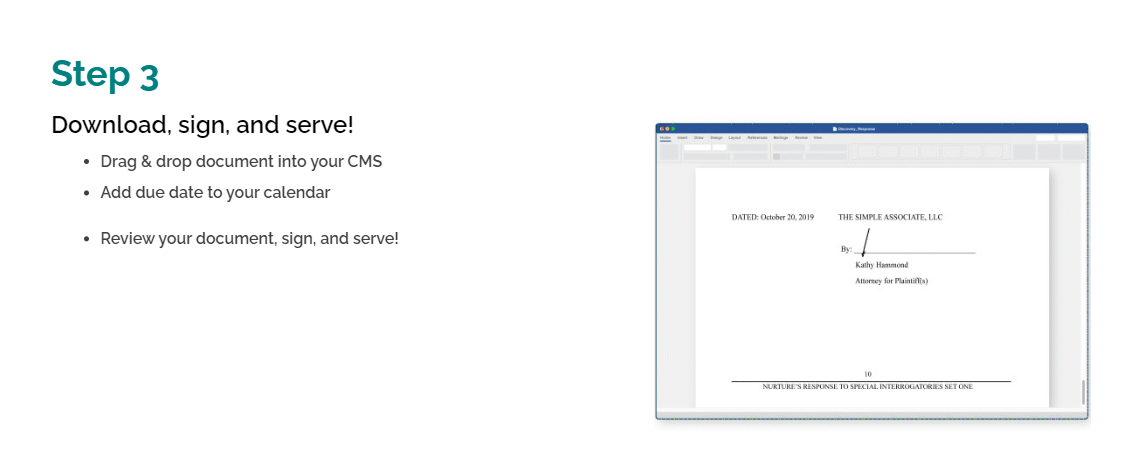
How to Automate Legal Discovery
AI tools can also automate the creation of legal discovery documents, such as requests for admission, requests for production, and interrogatories.
These facilities mean you can automate the initiation aspect of legal discovery work, not just the response.
1. Design Your Document
The first step is to draft your propounding discovery document. Solutions begin by collecting essential information to populate the request.
For example, Briefpoint asks for information about the case name, request type (request for admission, request for production, or interrogatory), and the responding party.
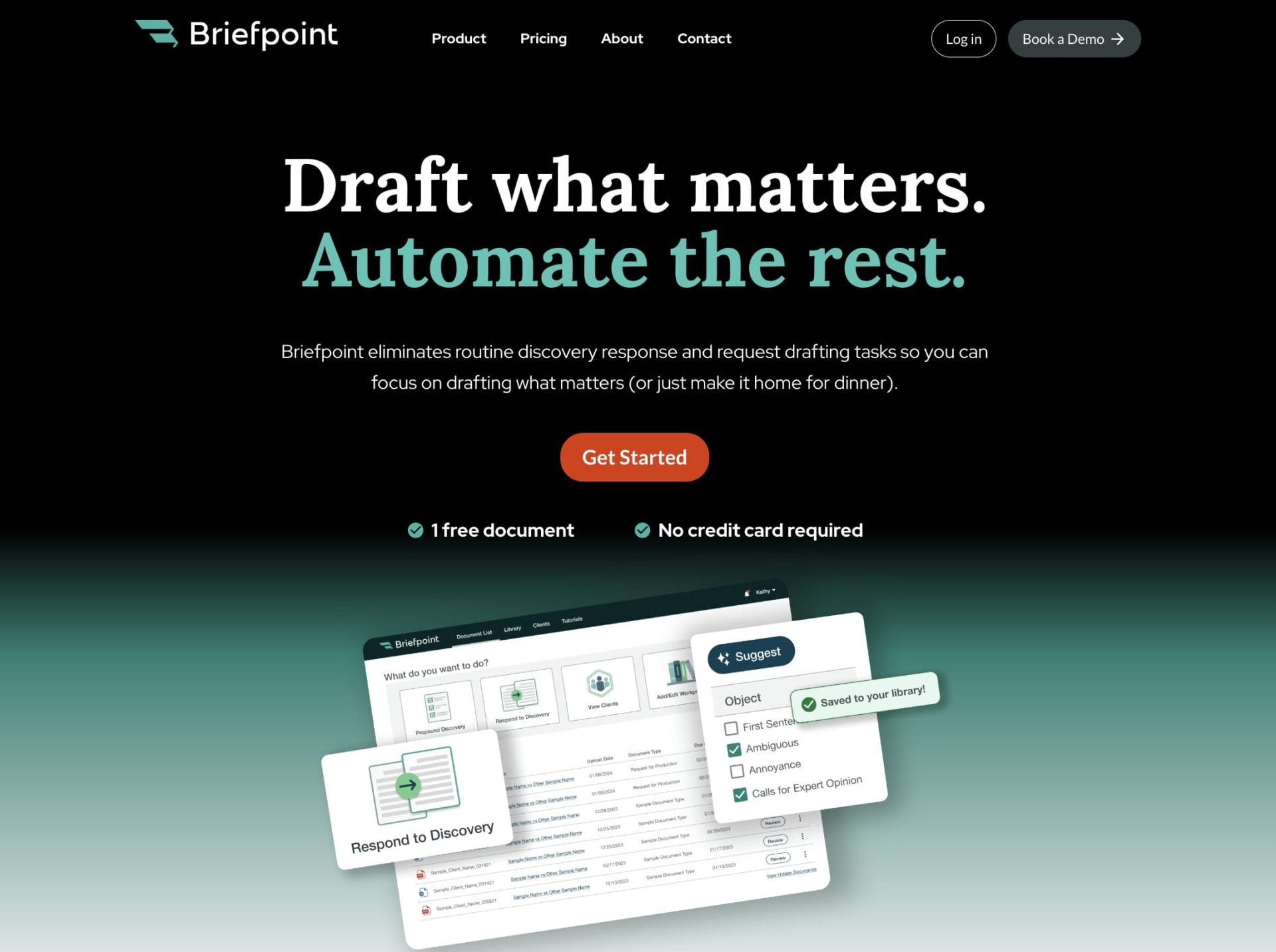
You can also link it to an existing case or client or a new one.
2. Add Requests
The next step is to add your requests. Automation software accelerates this process by including pre-built requests grouped by case type and theories of law.
For example, Briefpoint lets you select interrogatories related to “auto torts” with a click and add them to your request.
3. Document Review
The final step is to download and review your newly generated request document. Again, Briefpoint lets you edit it in Word, which is ready to attach to an email or print after the review process.
If you want to learn more about Briefpoint’s process, book your discovery call today!
The Benefits of Automating Legal Discovery
Automating legal discovery work isn’t just about saving time and money—though it certainly does that.
The real benefits go beyond efficiency. It helps law firms improve accuracy, client relationships, and overall workflow, which will ultimately translate to a better bottom line and—even better—more resolved cases for clients.
Here’s a deeper look into how automating legal discovery can transform the way you manage cases.
Reducing Errors in Discovery Responses
One of the most significant advantages of using automation tools in legal discovery is the reduction in errors.
These tools can sift through large volumes of documents and data to quickly identify key themes and relevant information. By doing so, they help make sure your responses are accurate and comprehensive, minimizing the risk of oversight.
Protecting Privileged Information
Handling large volumes of documents manually increases the risk of accidentally revealing privileged information.
Automation tools are designed to offer permissible retorts to help you carefully craft responses while protecting sensitive data.

These tools can highlight or hide privileged information, which helps make sure you comply with legal requirements and maintain the confidentiality of involved parties.
Improving Client Relationships
Another often overlooked benefit of automating legal discovery is how it improves your relationship with clients.
With less time spent sifting through documents and performing repetitive tasks, you can dedicate more time to the parts of your job that matter most—working closely with your clients and building strong relationships.
Shifting Focus to Higher-Value Tasks
By automating the drudgery of document review and discovery, tools like Briefpoint allow you to shift your attention to more meaningful work.
Rather than getting bogged down in repetitive, manual tasks, you can focus on case strategy, negotiations, and court preparation.
Automating discovery gives you the opportunity to operate more efficiently, helping you focus on the parts of your job that bring you the most satisfaction and success.
Improving Efficiency and Workflow
Ultimately, automating legal discovery transforms the way your firm operates.
It creates more efficient workflows, reduces manual errors, and speeds up the document review process. This allows your firm to handle more cases or complex matters without overwhelming your team.
Overhaul Your Discovery Workflow With Briefpoint
Legal discovery doesn’t have to drain your day. With Briefpoint, you can eliminate tedious tasks, improve accuracy, and spend more time where it matters—working with clients and advancing cases.
Say goodbye to the endless hours spent drafting discovery documents and hello to a smarter, faster workflow. Over 500 law firms are already transforming their practices with Briefpoint’s innovative AI-powered tools.
Isn’t it time your firm joined them? Book a demo today and discover how Briefpoint can help take your practice to the next level.
Enjoy a Cost-Effective Discovery Process With Briefpoint
Discovery responses cost firms $23,240, per year, per attorney. $23,240 estimate assumes an associate attorney salary of $150,000 (including benefits – or $83 an hour), 20 cases per year/per associate, 4 discovery sets per case, 30 questions per set, 3.5 hours spent responding to each set, and 1800 hours of billable hours per year.
Book a demo and save on these costs with Briefpoint.
FAQs About Automate Legal Discovery
How do you automate legal work?
The degree to which you can automate legal work depends on the tools you use. Next-generation software, like Briefpoint, uses advanced AI to extract relevant information from discoveries and provides a template, legally permissible, and editable responses you can include.
What is legal electronic discovery?
Legal electronic discovery, or e-discovery, refers to the process of identifying, collecting, and sharing electronically stored information (ESI) in a legal case. This can include emails, digital documents, and other forms of electronic data, often managed through specialized software.
What is legal document automation?
Legal document automation uses software to create, manage, and edit legal documents automatically. By relying on templates and pre-defined rules, tools like Briefpoint help legal teams generate accurate legal documents in less time, reducing errors and manual effort.
Can paralegals do discovery?
Yes, paralegals play a key role in discovery by reviewing documents, organizing evidence, and assisting with responses. With discovery automation tools, paralegals can complete these tasks faster and more accurately, enhancing their productivity and value to the legal team.
What is e-discovery in law?
E-discovery is simply the electronic version of conventional discovery. It involves submitting digital evidence, requests for production, requests for admission, and interrogatories via digital means (over the Internet) instead of by hand or mail.
How do you automate the collection of Electronically Stored Information (ESI)?
Automating the collection of Electronically Stored Information (ESI) involves using electronic discovery technology to streamline the process of finding, preserving, and gathering digital data to share in state and federal courts. This is typically done by setting up systems that can automatically search through emails, cloud storage, and other digital platforms to find relevant information based on specific criteria like keywords or dates. These systems also make sure that the data is preserved in its original form to prevent any alterations and have tools for producing electronic documents.
The information provided on this website does not, and is not intended to, constitute legal advice; instead, all information, content, and materials available on this site are for general informational purposes only. Information on this website may not constitute the most up-to-date legal or other information. This website contains links to other third-party websites. Such links are only for the convenience of the reader, user or browser.
Readers of this website should contact their attorney to obtain advice with respect to any particular legal matter. No reader, user, or browser of this site should act or refrain from acting on the basis of information on this site without first seeking legal advice from counsel in the relevant jurisdiction. Only your individual attorney can provide assurances that the information contained herein – and your interpretation of it – is applicable or appropriate to your particular situation. Use of, and access to, this website or any of the links or resources contained within the site do not create an attorney-client relationship between the reader, user, or browser and website authors, contributors, contributing law firms, or committee members and their respective employers.
Top 5 Legal Workflow Management Software
Top 5 Legal Workflow Management Software
Managing a law firm involves juggling countless tasks, from tracking deadlines to drafting documents and keeping clients informed.
Many of these tasks are repetitive and time-consuming, leaving less room for strategic, high-value work. In fact, data from 2020 shows that more than 63% of tasks performed by legal professionals are rules-based, repetitive, and require no interpretation or judgment.
Legal workflow management software offers a solution by automating routine processes and organizing workflows so law firms operate more efficiently. In this article, we’ll explore what these tools are, how they work, and which platforms stand out.

What is Legal Workflow Management Software?
Legal workflow management software is a digital solution designed to bring order to the chaos of legal operations. It acts as a central hub for organizing and automating essential tasks like document drafting, legal research, data entry, and more.
At its core, legal workflow automation software replaces manual, time-consuming processes with automated workflows to give legal professionals more time to focus on strategy and client relationships. Common features include:
- Automated workflows: Tedious tasks like document creation or compliance checks become effortless with built-in templates and workflows.
- Task tracking: Track cases, tasks, and deadlines without digging through emails or spreadsheets.
- Integration capabilities: Link it with tools like Outlook, Google Workspace, or billing software to keep everything connected.
- Client management: Maintain detailed records, case notes, and communication histories in one easily accessible location.
The goal of such software is to make it easier to stay organized, meet deadlines, and focus on providing exceptional client service without unnecessary stress or errors.
Best Legal Workflow Management Tools For Your Tech Stack
Having the right tools in your legal tech stack can save time and reduce stress. But which ones should you choose? We’ve compiled a list of the best legal workflow automation tools so you can narrow down your choice.
1. Briefpoint
Briefpoint is a cutting-edge tool designed to simplify one of the most tedious aspects of legal work—responding to discovery requests.

By leveraging advanced AI and machine learning, Briefpoint automates the preparation of discovery documents, which allows legal professionals to focus on higher-value work instead of getting bogged down by repetitive administrative tasks.
It handles everything from scanning documents for key information to generating properly formatted responses that comply with local court rules.
Whether you’re a solo practitioner or part of a busy legal team, Briefpoint is a must-have for efficiency and accuracy in discovery-related workflows.
Best Features
Automated document drafting: Upload discovery requests, and Briefpoint’s AI extracts key details like court names, case numbers, and request types.
Objection management: Easily add objections to requests or interrogatories with a simple click.
Customizable formatting: The system applies local court formatting rules for professional results.
Integration with Word: Download partially completed briefs, ready to be finalized in Word.
Broad court compatibility: Supports discovery requests across all U.S. state courts.
Pros
Drastically reduces the time spent on drafting discovery documents
Improves accuracy by automating repetitive tasks prone to human error
Offers a simple, user-friendly interface that’s easy to learn
Ensures compliance with local court rules by applying proper formatting
Supports collaboration by allowing team members to review and adjust drafts
Compatible with all U.S. state courts, making it versatile for legal teams nationwide
2. Clio
Clio is an all-in-one legal workflow management solution designed to simplify operations for law firms of any size. It provides everything you need for case management, billing, and client communication, all within a single, easy-to-use platform.

Source: G2
With extensive integration options and a focus on efficiency, Clio helps legal professionals manage tasks like client intake, time tracking, and payment processing while staying organized and compliant.
Best Features
- Comprehensive case management: Track all client and case details, deadlines, and communications in one place.
- Billing and payments: Generate invoices and accept payments directly through the platform.
- Client intake management: Simplify onboarding with customizable intake forms and workflows.
- Over 200 integrations: Works seamlessly with tools like Google Workspace, Microsoft 365, and QuickBooks.
- Mobile app: Manage your practice on the go with Clio’s fully featured mobile app.
Pros
- Scales well for firms of all sizes
- Strong integration capabilities for better functionality
- User-friendly design simplifies complex tasks
- Offers detailed reporting for better insights
- Mobile app mirrors desktop features for flexibility
Cons
- Higher pricing can be a barrier for smaller firms
- Some users may find the feature set overwhelming initially
- Advanced features may require additional setup time
Pricing
Clio offers multiple pricing tiers starting at $49 per user per month. The most basic plan offers calendar management, online payment options, and time tracking. Higher-tier plans unlock advanced features such as client intake automation and enhanced reporting.
3. MyCase
MyCase is an all-in-one legal management platform designed to simplify case management, billing, and client communication.
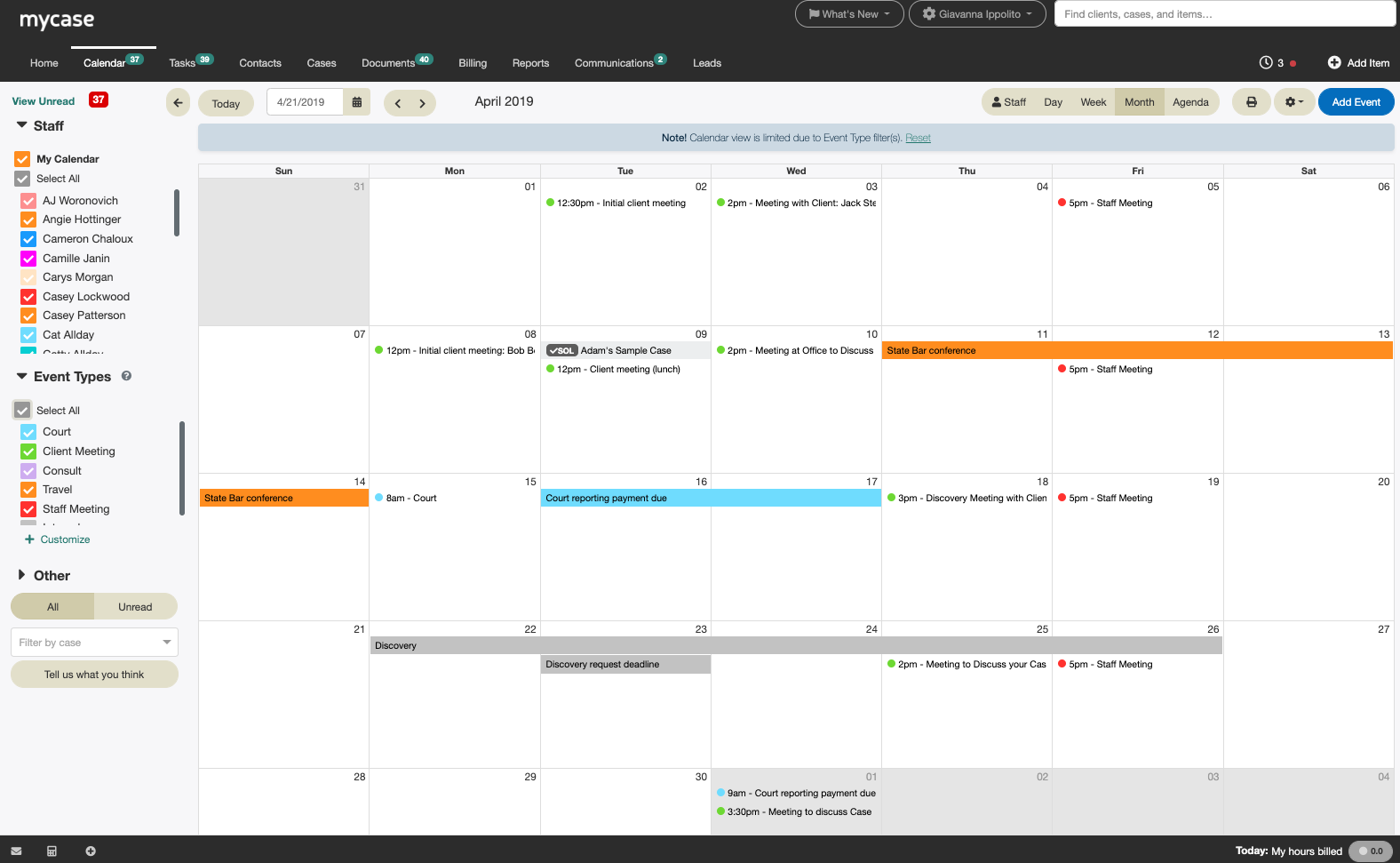
Source: G2
It’s tailored for small to mid-sized law firms and provides an intuitive interface that makes tracking tasks, managing deadlines, and handling invoicing more efficient.
Best Features
- Integrated time tracking and invoicing: Manage billable hours and generate invoices directly within the platform.
- Secure client communication: Use encrypted client portals to share updates, documents, and messages.
- Deadline and task management: Keep track of all important dates and to-dos to stay organized.
- Document management: Store, organize, and access all case-related files in one central location.
- Mobile app support: Manage your practice on the go with MyCase’s mobile-friendly features.
Pros
- Combines case management and billing in one platform
- Offers secure client communication with encrypted portals for better client satisfaction
- Easy-to-navigate interface, even for less tech-savvy users
- Includes mobile access for on-the-go management
Cons
- Limited customization for advanced reporting
- Some features may feel basic for larger firms
- Mobile app lacks some advanced functionalities
Pricing
MyCase pricing starts at $49 per user per month for the Basic plan. It includes core features like task management, a client portal, and expense tracking.
4. Smokeball
Smokeball is a cloud-based legal practice management software built to improve efficiency for small law firms. It offers automatic time tracking, document automation, and daily task management features to help lawyers and staff stay organized and productive.

Source: Smokeball.com
With a user-friendly interface and frequent updates, Smokeball caters to firms looking for an efficient way to manage their daily operations without unnecessary complications.
Best Features
- Automatic time tracking: Keeps track of your work hours without requiring manual entry, ensuring accurate billing.
- Document automation: Simplifies the creation of legal documents using pre-built templates.
- Daily digest: A feature that provides an overview of deadlines, tasks, and appointments to keep you on track.
- Client and matter management: Centralized storage for client information and case files.
- Email and calendar integration: Syncs seamlessly with Outlook to keep communication and scheduling in one place.
Pros
- Saves time with automatic time tracking
- Excellent document automation features for faster drafting
- Intuitive and easy-to-learn interface
- Frequent updates make sure the software stays current
- Strong customer support
Cons
- Higher price point compared to some competitors
- Limited customization options for larger firms
- Some advanced features may have a learning curve
Pricing
Smokeball plans are currently not available for public viewing.
5. Checkbox
Checkbox is a no-code platform built to help legal teams automate repetitive workflows and create customized solutions for their unique needs.
Source: G2
Designed for efficiency and flexibility, Checkbox allows users to build digital workflows, automate compliance tasks, and create self-service portals without requiring technical expertise. It’s particularly well-suited for law firms handling high volumes of routine tasks or processes.
Best Features
- Drag-and-drop workflow builder: Easily design workflows without coding skills.
- Pre-built templates: Get started quickly with customizable templates for legal workflows.
- Self-service portals: Create portals for clients or internal teams to streamline task management.
- Integration options: Connect with tools like Outlook, Google Workspace, and more.
- Scalability: Adaptable for firms of various sizes and industries.
Pros
- User-friendly interface makes automation accessible
- Ideal for compliance-heavy processes
- Highly customizable to suit specific legal needs
- Enables faster service delivery with client portals
- Supports integrations to connect with existing tools
Cons
- Best suited for teams with clear workflow requirements
- Limited analytics and reporting capabilities
- Advanced features may require some initial setup
Pricing
Checkbox has no direct pricing on its website.
Briefpoint Automates The Most Tedious Part of Your Workflow
Legal workflow software has the power to redefine how your firm operates, turning time-consuming processes into seamless tasks.
Tools like Briefpoint stand out by addressing specific challenges, like automating discovery responses, saving valuable hours, and reducing stress for legal professionals.
Why spend countless hours on repetitive tasks when Briefpoint can handle them with precision and speed? Save time, cut down on errors, and focus on delivering outstanding service to your clients. Don’t just manage your workload—transform it.
Schedule a free demo with Briefpoint today and see how it can revolutionize your workflow.
Get Unlimited Savings With Document Automation
Discovery responses cost firms $23,240, per year, per attorney. $23,240 estimate assumes an associate attorney salary of $150,000 (including benefits – or $83 an hour), 20 cases per year/per associate, 4 discovery sets per case, 30 questions per set, 3.5 hours spent responding to each set, and 1800 hours of billable hours per year.
Book a demo and save on these costs with Briefpoint.
FAQs About Legal Workflow Management
What are 3 basic workflow management practices?
Effective workflow management relies on three key practices: clearly defining tasks, assigning responsibilities, and tracking progress. Clearly defined tasks help break processes into manageable steps while assigning responsibilities makes sure that every team member understands their role. Tracking progress using tools or software keeps the workflow on schedule and ensures deadlines are met.
What is legal workflow automation?
Legal workflow automation refers to the use of software to streamline repetitive tasks in legal practices. It handles processes like document drafting, case tracking, and deadline management automatically, reducing manual effort and minimizing errors. Legal teams can focus on providing better client service and tackling complex legal strategies by automating these workflows.
What are the 3 methods of workflow organization?
Workflows can be organized using three main methods: sequential, parallel, and dynamic. Sequential workflows follow a strict order where each task depends on the completion of the previous one. Parallel workflows allow multiple tasks to be completed simultaneously, which saves time. Dynamic workflows are more flexible, adapting to changes in priorities or external circumstances as needed.
What are the four types of workflow?
There are four primary types of workflows: process, project, case, and ad hoc. Process workflows are standardized and repetitive, such as client intake procedures. Project workflows are temporary and created for specific goals or initiatives. Case workflows are tailored to managing individual cases, commonly used in legal and medical fields. Ad hoc workflows are flexible and created on the spot for unique or non-recurring tasks.
The information provided on this website does not, and is not intended to, constitute legal advice; instead, all information, content, and materials available on this site are for general informational purposes only. Information on this website may not constitute the most up-to-date legal or other information.
This website contains links to other third-party websites. Such links are only for the convenience of the reader, user or browser. Readers of this website should contact their attorney to obtain advice with respect to any particular legal matter. No reader, user, or browser of this site should act or refrain from acting on the basis of information on this site without first seeking legal advice from counsel in the relevant jurisdiction. Only your individual attorney can provide assurances that the information contained herein – and your interpretation of it – is applicable or appropriate to your particular situation. Use of, and access to, this website or any of the links or resources contained within the site do not create an attorney-client relationship between the reader, user, or browser and website authors, contributors, contributing law firms, or committee members and their respective employers.
Clio vs. MyCase: A Complete Comparison Guide
Clio vs. MyCase: A Complete Comparison Guide
Picking the right practice management software for your law firm can feel like a tough call—especially when Clio and MyCase both seem to check so many boxes. They’re popular, packed with features, and designed to simplify how your firm operates.
So, how do you choose?
We’ve got you covered. In this guide, we’ll break down the key features, differences, and pricing of Clio and MyCase while showing you how Briefpoint can complement either platform. By the end, you’ll know exactly what your firm needs to run smoothly.

What Is Clio?
Clio is cloud-based legal practice management software designed to make running a law firm a whole lot easier.
It helps you handle everything from case management and document organization to tracking time and billing clients.

Whether you’re a solo lawyer or part of a larger firm, Clio is one of the best options for an all-in-one legal practice management system.
One of its biggest perks is how it connects with other tools you’re probably already using, like Google Workspace or Microsoft 365. So, if you’re looking to iron out your workflow and keep things organized, Clio might be just what your firm needs.
Despite Clio being an extremely popular tool for legal professionals seeking intuitive practice management software, it has a worthy rival: MyCase.
What Is MyCase?
MyCase is a straightforward, cloud-based legal management tool designed to help law firms handle their daily operations smoothly.
Like Clio, it’s all about making things easier—whether it’s organizing cases, tracking time, managing documents, or billing clients.
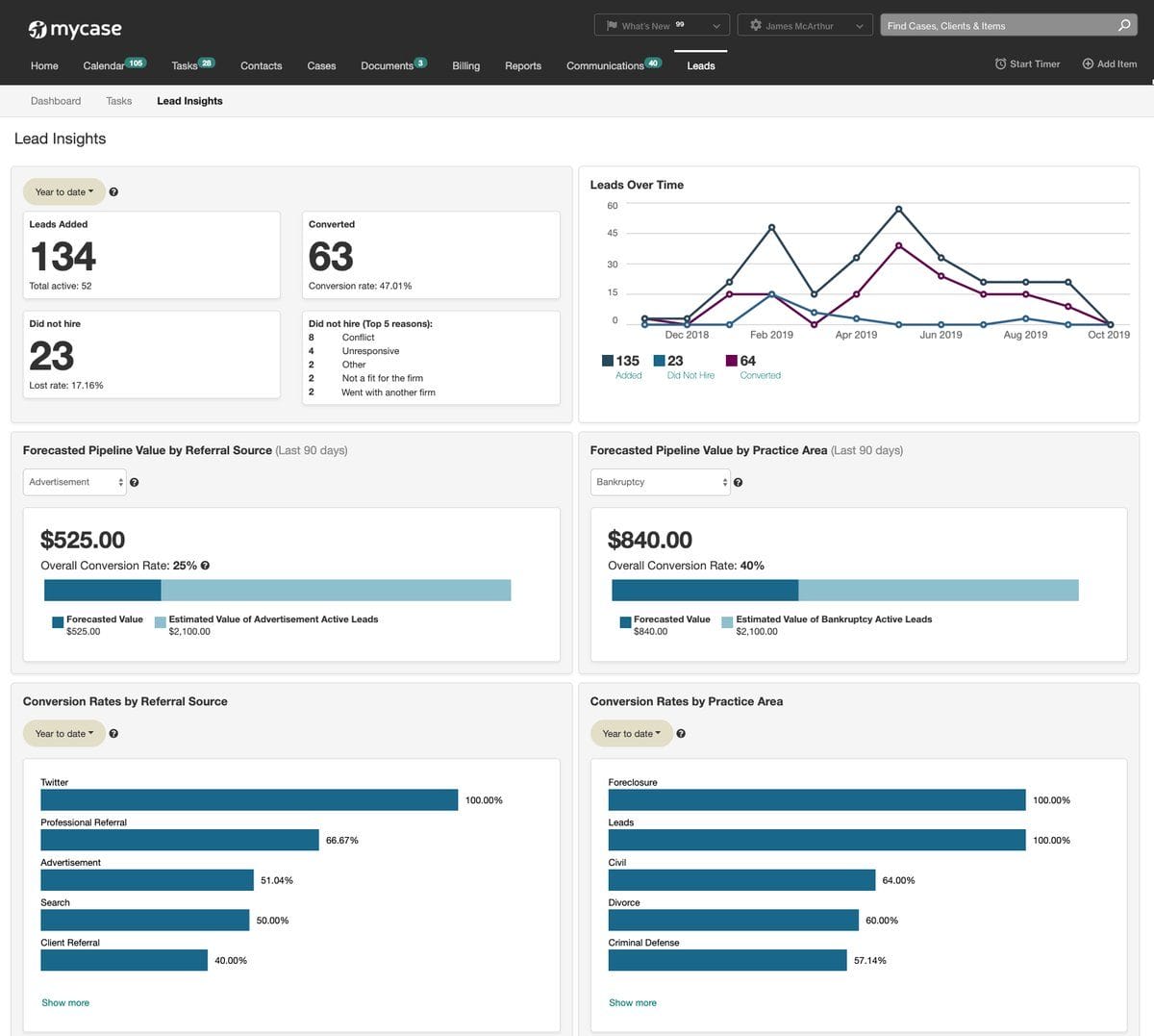
One of its key strengths is the built-in and secure client portal, where you can communicate and share documents with your clients without the hassle of extra emails.
Law firms with smaller teams love MyCase because it’s a breeze to navigate, leaving them more time to focus on more valuable work.
What Is Briefpoint?
Briefpoint is an AI-powered discovery document automation tool that lets legal professionals prepare discovery responses and request documents within minutes.
Instead of spending hours copying and pasting or manually writing these documents, Briefpoint lets you automate the whole process.

How does it work? You just have to upload your discovery request, and Briefpoint’s AI system will automatically extract as much information as it can, including routine data like case numbers, court names, parties, and more.
Then, it fills out routine data within your brief. At this point, you can add objections by clicking the interrogatories you want to include.
Briefpoint lets you download the document at any point so you can add finishing touches to Word.
Briefpoint also has Bridge, a built-in tool that gathers client input and simplifies complex legal terminology into plain English. It then shares this information with your clients and seamlessly incorporates their feedback into your working documents without back-and-forth emailing.
Test Briefpoint yourself by scheduling a demo here.
Clio vs MyCase: Feature Comparison
When it comes to comparing Clio and MyCase, it’s important to break down their key features and see how they stack up against each other.
At first glance, the two platforms seem to offer a lot of the same features, but as you dig deeper, you’ll find they have distinct approaches to case management, client intake, document organization, and the financial aspects of running a business.
Case Management
Clio offers a robust case management system designed to keep everything organized. You can track case timelines, store related documents, and even collaborate with your team.
Plus, it’s customizable, letting you adjust workflows to fit how your firm operates, and integrates with a variety of other tools, giving you a lot of flexibility.
MyCase also provides a solid case management system but leans a little more into simplicity. With a case management system that’s sturdy and reliable, the slight trade-off is a user interface that’s straightforward and easy to grasp.
You can organize cases, assign tasks, and track case progress without too much hassle even if you have limited technical expertise.
However, MyCase has a significant edge in client communication—its portal allows for easy client updates and collaboration, which makes it super convenient for keeping clients in the loop.
Client Intake and Lead Management
Clio offers customizable client intake forms that you can embed on your website to streamline the onboarding process for new clients. It automates a lot of data entry and contact management, which makes it faster and easier for both your firm and your clients.
Aside from client management, Clio also integrates lead management features. This means you can track potential clients from their initial inquiry to becoming active clients, all in one platform.
On the other hand, MyCase offers a more basic client intake feature, which covers the essentials but doesn’t offer as much customization.
It gets the job done for firms looking for a simple, straightforward intake process, but if you want more flexibility, Clio has the edge here. However, it lacks lead management features.
Document Management
Clio’s document management system is highly secure and easy to navigate. It lets you store, organize, and share documents both within your team and with clients or third parties. Better yet, the platform integrates with tools like Google Drive, Dropbox, and OneDrive, so it’s easy to keep everything in sync.
MyCase also provides document storage and sharing, but, again, with a more user-friendly interface. It may not have as many third-party integrations as Clio, but it makes up for it with simplicity. If ease of use is your priority, MyCase might be more up your alley.
Billing and Time Tracking
Clio offers a comprehensive billing system that includes time tracking, invoicing, and expense management.
You can track your time directly within the platform and then convert that into professional-looking invoices. Clio’s billing system is customizable, which gives you more control over how you bill clients and manage your firm’s finances.
MyCase also offers billing and time tracking, but it focuses on keeping things as simple as possible. Its invoicing system is easy to navigate, allowing you to create and send invoices with just a few clicks. While it might not be as customizable as Clio, it’s perfect for firms that want a quick, no-fuss solution.

Payment Processes
Clio makes it easy for clients to pay with Clio Payments, a built-in feature that allows for secure online payments via credit card or bank transfer. You can set up automated reminders, which helps make sure you get paid faster. Plus, Clio’s payment processing integrates seamlessly with its billing system.
MyCase has built-in payment processing, integrating with LawPay to handle online payments. It supports credit card payments and allows for partial payments, which can be useful for clients who prefer to pay in installments. MyCase also provides automatic payment reminders, so it’s easier to stay on top of billing.
Clio vs. MyCase: Key Differences
As you can see, Clio and MyCase have plenty in common, but their differences can help you figure out which one is the better fit for your law firm.
Target Market
Clio is designed to cater to a wide range of law firms, from solo practitioners to larger multi-lawyer firms. Its broad feature set and extensive integrations make it especially appealing to firms that handle complex cases or need automated workflows and more advanced tools to manage a larger volume of work.
Because of its flexibility, Clio tends to attract firms that are willing to spend time learning the ins and outs of a more customizable platform.
MyCase, on the other hand, is primarily aimed at small to mid-sized law firms that value simplicity and ease of use. It’s particularly popular among firms that want to get up and running quickly without a steep learning curve.
Additionally, MyCase’s focus on client communication and straightforward design makes it a favorite for firms that don’t need a lot of customization but still want a solid, dependable tool for managing cases and expense tracking.
Key Features
What is each platform known for? One of Clio’s standout features is its deep integration capabilities. With over 200 third-party app integrations, Clio is great for firms that need a highly customizable and flexible system. Whether you want to integrate with email tools, accounting software, or case research tools, Clio likely has an option for it.
While MyCase may not offer the same breadth of integrations as Clio, it makes up for it with its client portal, which is incredibly easy to use. The portal allows clients to view case updates, share documents, and communicate directly with their attorneys, all in one place.
This focus on simplifying client communication is one of MyCase’s strongest selling points, particularly for firms that want to improve how they interact with clients without needing to fiddle with a bunch of settings.
Ease of Use
Clio offers a lot of functionality, but that comes with a bit of a learning curve. It’s not overly complex, but if you want to take full advantage of everything Clio has to offer, you’ll likely need some time to get familiar with its features.
MyCase is known for its ease of use. It’s designed to be intuitive, and most users can get started quickly with minimal training.
So, if you’re looking for a system that won’t take much time to learn and doesn’t require a ton of customization, MyCase might be the better choice. Its intuitive interface makes it ideal for firms that want to focus on getting work done without getting bogged down in tech.
Pricing Structure
Clio offers four main pricing plans—EasyStart, Essentials, Advanced, and Complete—allowing firms to choose the level of functionality they need. While Clio tends to be on the pricier side (starting at $49 per user per month), especially for the more feature-rich plans like Clio Manage and Clio Grow, you’re paying for access to a wide array of tools and integrations.
Clio’s pricing is flexible enough that solo practitioners can get a good deal, while larger firms can scale up for more advanced needs.
MyCase offers three pricing plans—Basic, Pro, and Advanced—with the starting point also being $49 per user per month. As expected, the first tier offers basic functionalities, while the more expensive ones add new features useful for firm and desktop document management.
Which One Is Better for Your Law Firm?
The choice between Clio and MyCase really depends on your firm’s specific needs. Both platforms offer excellent features but cater to slightly different types of law firms.
If your firm needs a more feature-rich system with greater flexibility and customization, Clio might be the better fit. However, if you’re looking for something more straightforward and easy to use, with a focus on client communication, MyCase could be just what you need.
To help make your decision easier, here’s a quick comparison:
Feature | Clio | MyCase |
Case management | Robust and customizable with integrations | Simple and user-friendly |
Client communications | Basic client-sharing tools | Secure client portal for easy collaboration |
Client intake | Customizable forms with lead management | Basic forms, no lead management |
Document management | Advanced with third-party integrations | Easy to use but fewer integrations |
Billing and payments | Customizable with Clio Payments | Simple with LawPay integration |
How Does Briefpoint Fit Into the Mix?
While Clio and MyCase handle the essentials of practice management, Briefpoint adds a layer of efficiency that neither platform offers: discovery document automation.
If you’ve ever spent hours drafting requests for admission, production, or interrogatories, you know how tedious it can be. That’s where you can insert Briefpoint—it automates the whole process, cutting the time down to just minutes.
Here’s how it works:
- Smart data extraction: Just upload your discovery request, and Briefpoint’s AI pulls in routine details like case numbers, court names, and parties automatically.
- Quick objections: Need to add objections? No problem. Just click the ones you want, and they’re instantly added.
- Client-friendly collaboration: With Briefpoint Bridge, you can simplify legal language for your clients and collect their input directly—no more endless email chains.
This tool isn’t just about saving time—it’s also about reducing errors and improving overall accuracy. Whether your firm uses Clio or MyCase, Briefpoint integrates seamlessly to complement your practice management software with a simpler discovery process.
Book your discovery call today!
Save Even More With Discovery Automation
Discovery responses cost firms $23,240, per year, per attorney. $23,240 estimate assumes an associate attorney salary of $150,000 (including benefits – or $83 an hour), 20 cases per year/per associate, 4 discovery sets per case, 30 questions per set, 3.5 hours spent responding to each set, and 1800 hours of billable hours per year.
Book a demo and save on these costs with Briefpoint.
FAQs About Clio vs MyCase
Which is easier to use, Clio or MyCase?
MyCase is generally easier to use with a more straightforward interface, while Clio offers more features but may take longer to learn.
Can both platforms handle client intake?
Yes, but Clio offers more customizable intake forms and lead management, while MyCase provides a simpler intake process.
Which is better for small law firms?
MyCase is typically better for small firms due to its simplicity and ease of use.
Does Clio or MyCase have better document management?
Clio offers more advanced document management with automation and integrations, while MyCase focuses on basic storage and ease of use.
How do their pricing models differ?
Clio has flexible, tiered pricing based on features, while MyCase offers a single, flat-rate plan.
The information provided on this website does not, and is not intended to, constitute legal advice; instead, all information, content, and materials available on this site are for general informational purposes only. Information on this website may not constitute the most up-to-date legal or other information. This website contains links to other third-party websites. Such links are only for the convenience of the reader, user or browser. Readers of this website should contact their attorney to obtain advice with respect to any particular legal matter. No reader, user, or browser of this site should act or refrain from acting on the basis of information on this site without first seeking legal advice from counsel in the relevant jurisdiction. Only your individual attorney can provide assurances that the information contained herein – and your interpretation of it – is applicable or appropriate to your particular situation. Use of, and access to, this website or any of the links or resources contained within the site do not create an attorney-client relationship between the reader, user, or browser and website authors, contributors, contributing law firms, or committee members and their respective employers.
AI Litigation: How to Use New Tech to Upgrade Old Workflows
AI Litigation: How to Use New Tech to Upgrade Old Workflows
Artificial intelligence is making waves in just about every industry, and the legal field is no different. While nothing will replace the expertise of skilled legal professionals, AI is quickly becoming a valuable tool for law firms, helping streamline tasks, improve efficiency, and even shape case strategies.
It’s not just about how lawyers work—AI is also influencing the cases they’re handling. For example, disputes over AI models like ChatGPT using copyrighted content are becoming more frequent, raising big questions about the legal implications of this technology.
In this article, we’ll take a closer look at AI’s role in litigation, from the advantages it offers law firms to the challenges and legal complexities it brings. With AI becoming more sophisticated by the day, staying on top of these developments is essential for legal professionals.
So, what do you need to know about AI in the legal world?

The Impact of Artificial Intelligence on Litigation
Artificial intelligence is reshaping litigation by streamlining research, automating discovery, and improving access to justice. While these advancements drive efficiency and innovation, they also bring challenges like adapting to evolving tools and rising client demands.
Let’s explore AI’s biggest impacts on modern legal practice.
Optimizing Research
Any lawyer practicing during the pre-computer era can tell you just how long it took to research. Without digital repositories, the labor of manual research “slowed” all litigation.
“Slowed” is in quotes because that prior pace is only “slow” in retrospect. Given clients’ expectations of the time, litigation’s relatively leisurely pace was of no consequence.
Fast forward to emails—purported bastions of time savings—whose efficiency gains were quickly eclipsed by client expectations, causing a new world of immediate demands and, consequently, fast-paced litigation practices.
So too have the efficiency gains made by digital research repositories been met with heightened client expectations. Memos once expected next week are now scheduled within the next hour.
With increasingly capable AI research tools, collecting and filtering research is nearly instantaneous. Will these tools save attorneys’ time? Certainly, but that time may soon be weighted by increased client expectations.
Saving Time
AI litigation tools help law firms save significant time by automating the discovery response process.
Generative AI tools such as Briefpoint make it much faster to construct the vital documents that law firms need to handle discovery efficiently. According to insights, tools such as Briefpoint can reduce the time spent on these documents by as much as 87%.
These types of AI tools don’t just help to save time. They help uphold the standardization of a law firm’s work product so that firms can trust that every document they generate with Briefpoint meets their high-quality expectations.
Generative AI models essentially take care of the time-consuming aspects of document creation. However, law firms can still add their objections and responses, which make sure that they’re still quality documents based on their firm’s gold standards.
Reducing Barriers to Legal Assistance
Artificial intelligence software makes it easier for people who may historically not have had access to legal support to get the help they need. Many instances occur where people are unable to pursue legal avenues because of a lack of capital or know-how.
AI software has allowed people from these groups to begin pursuing legal damages with a few clicks of a button. For instance, there are tools that instantly generate a personalized lawsuit against robocall companies.
This aspect of AI litigation is still in development, but it’s expected to grow significantly in the coming years. While broadly positive, the downside could be that courts are overwhelmed by quickly generated lawsuits even when the grounds for the lawsuit are relatively thin.
Skill Development for Legal Professionals
AI litigation tools are just beginning to infiltrate the legal system, but they’ll be widespread in the coming years.
To make the most of these advanced tools, lawyers and law firm workers will need to upskill to learn how to leverage the impact of the software that’s available. As with all industries, AI isn’t designed to take over from law professionals; it’s there to supplement them.
Legal professionals will need to learn how to select the right tool for the job, use the tools effectively, and generally stay up to date with new developments to stay ahead of the curve and make sure they’re getting the most from these powerful tools.
Better Decision Making
Though the technology to help lawyers enhance their decision-making processes is still in its infancy, it’s anticipated to become more advanced and widely available in the coming years.
Lawyers will be able to use these tools to gain valuable insights into a case’s predicted outcome, analyze similar cases from the past, and attain a deeper understanding of the broader context of their case. This will help law firms plan their strategy more effectively and make better, more informed decisions.
Customer Service
Customer service is paramount in all industries, especially in the legal field, where customers have a more significant emotional stake than in other sectors.
AI-powered chatbots can make it easier for law firms to manage customer requests and questions, often resolving the issue without human intervention.
Even if a human response is required, the information gathered by an AI chatbot can help reduce the amount of time the professional spends crafting a response since it will already have gathered the necessary information.
How to Integrate AI Into Your Legal Practice
Integrating artificial intelligence into your legal practice can transform how litigation lawyers manage their workload. From automating repetitive tasks to improving decision-making, AI offers tools that save time and improve efficiency.
However, successful adoption requires a strategic approach to make sure the technology complements your practice while maintaining ethical and professional standards. So, we’ve created a guide to help you seamlessly incorporate AI into your litigation processes.
Assess Your Needs and Goals
Before diving into AI tools, take a step back and think about where they can truly help in your practice.
What tasks eat up the most time? Is it sifting through case law, drafting endless documents, or managing the overwhelming discovery process? These repetitive, time-intensive activities are prime candidates for AI to lighten the load.
Next, get clear on what you want to achieve. Do you need faster turnaround times for your clients? Or maybe you’re looking for tools that improve document consistency and accuracy? Defining these goals will make it easier to choose the right solutions that fit your practice.
Taking the time to assess your needs and set objectives makes sure the tools you adopt actually solve the challenges you face and make your workflow smoother.
Research AI Tools for Litigation
With so many AI tools available, it’s essential to focus on platforms specifically designed for litigation.
Start by exploring tools that handle common legal tasks:
- Legal research
- Document drafting
- Discovery management
These can significantly reduce the time spent on routine work while maintaining accuracy.
Consider platforms tailored to litigation needs. For example, Briefpoint is a powerful tool for automating discovery responses, saving time while improving consistency. Other AI tools offer features like case outcome analysis that can help you evaluate potential strategies based on similar cases.
When researching tools, prioritize user-friendly platforms that integrate well with your existing systems. Check reviews, request demos, and compare features to make sure you’re choosing solutions that align with your practice’s unique requirements.
Choose the Right Tools
Picking the right AI tools is a game-changer for your litigation practice, but it takes some thoughtful consideration.
You’ll want to make sure the tools you choose don’t just tick the basics—they should genuinely fit your needs and help you work smarter. Start by checking how well a tool aligns with your practice’s daily tasks. Does it handle research, drafting, or case analysis with ease?
It’s also important to think about the bigger picture. Can the tool grow with your practice? Scalability is key if you want it to stay useful as your workload increases.
And let’s not overlook security—your clients trust you with sensitive information, so the platform you use needs to have top-notch data protection features.
Here’s a quick checklist to guide your decision:
- Features: Does it address your pain points and help with critical litigation tasks?
- Ease of use: Will your team find it intuitive without needing hours of training?
- Cost: Is it reasonably priced, and does the value justify the investment?
- Compatibility: Will it integrate smoothly with your current systems?
- Scalability: Can it handle growth as your practice expands?
- Security: Does it safeguard client data with strong protections?
Remember: Taking the time to evaluate these aspects ensures you’ll invest in a tool that delivers real results.
Train Your Team
Getting the most out of AI tools starts with making sure your team knows how to use them effectively.
Begin with training sessions for both attorneys and support staff, focusing on how these tools can make their day-to-day tasks easier. Show them practical examples, like how to generate responses quickly, analyze case law efficiently, or manage discovery on a large scale.
The goal is to make everyone comfortable with the tools, so encourage questions and keep the training hands-on. Real-world examples can go a long way in helping your team see how these tools fit into their workflows.
Since AI is constantly evolving, it’s also important to keep the learning going. Offer regular updates or refresher sessions to cover new features and advancements. This way, your team stays ahead of the curve and is fully equipped to leverage AI in their work.
Start with a Pilot Project
When introducing AI into your practice, it’s smart to start small. A pilot project lets you test the waters, see how the tool fits into your workflows, and work out any hiccups before going all in. Here’s how to make it work:
- Pick a specific task or case: Focus on something manageable, like drafting discovery documents or handling legal research.
- Watch how it performs: Keep an eye on time saved, accuracy, and how well it integrates into your process.
- Spot any roadblocks: Identify any areas where the tool might not be meeting expectations or slowing things down.
- Get team feedback: Ask your team how it’s going—what’s working, what’s not, and what could be better.
- Tweak your workflows: Use what you’ve learned to make adjustments and fix any issues before rolling it out further.
Starting small gives you the chance to refine your approach and make sure AI becomes a helpful addition to your practice, not a disruption.
Integrate AI into Workflows
Once you’ve tested your AI tools and feel confident in what they can do, it’s time to make them part of your daily routine.
Let’s say you’re swamped with document reviews for a big case. Instead of manually combing through everything, an AI tool can handle the initial review, flagging key clauses, inconsistencies, or missing information. This saves hours of tedious work and lets you focus on the bigger picture—like shaping your case strategy.
The key is to ensure the AI doesn’t disrupt how your team already works. Instead, it should slide into your existing workflows seamlessly.
For example, if you’re using AI for discovery, you might automate the initial responses but still have attorneys review the final documents to make sure everything meets your firm’s standards.
Clear communication with your team is also essential. Make sure everyone knows what the AI is handling and where human input is still crucial. Regular check-ins can help you spot areas where the process might need tweaking.
Monitor Performance and Outcomes
To make sure your AI tools are delivering real value, it’s important to keep track of their performance. Focus on key areas that show their impact on your practice. Here are some metrics to monitor:
- Time saved
- Client satisfaction
- Error reduction
- Cost efficiency
- Adoption rates
- Workflow improvements
These metrics help you understand how well the tools are working. For example, are you completing tasks faster? Are clients happier with the results? Is the team using the tools effectively, and have your workflows become more efficient?
Prioritize Ethical and Legal Compliance
Incorporating AI technology into litigation comes with responsibilities that can’t be overlooked.
As AI lawsuits around privacy violations and copyright infringement become more common, it’s vital to make sure the tools you use adhere to legal regulations governing data security, privacy, and AI usage in litigation.
This includes, but is not limited to, the following:
- California Consumer Privacy Act (CCPA)
- General Data Protection Regulation (GDPR) for clients in the European Union
- Health Insurance Portability and Accountability Act (HIPAA) for handling sensitive medical information
Taking this step not only protects your practice but also safeguards your clients’ trust.
Set up a system for thoroughly reviewing AI-generated outputs, especially for tasks like generative AI litigation document creation. Attorneys should verify the accuracy of AI outputs and make sure they align with ethical standards.
This includes double-checking for potential copyright infringement or unintentional misuse of sensitive information.

Are Humans Still Superior?
It’s important to note that while AI tools are getting a lot of attention and are becoming increasingly popular, they won’t replace trained professionals anytime soon. While popular, they cannot account for all the various factors contributing to making a valuable, informed decision.
That only comes with experience and expertise. So, while they will certainly have a place in the legal field, the skilled professionals at the heart of the legal industry will still play the biggest role.
It’s also unclear whether AI will impact the roles of less-skilled jobs within the legal sector, such as legal assistants.
New Case Areas
So far, we’ve talked about how litigators and law firms may use AI software tools to enhance their operations. However, there’s another side to AI litigation, too—the law cases lodged because of AI.
This is a growing area of the law industry that is largely without precedent. We’re already seeing some high-profile cases, including artists claiming that AI companies are stealing their work or celebrities claiming that they’re using their likeness.
For example, let’s consider the lawsuit against OpenAI filed in the Northern District of California this year by authors Michael Chabon and Sarah Silverman.
The plaintiffs submitted a complaint alleging the company utilized their copyrighted material without authorization to train AI models. The central debate is whether using copyrighted texts for AI training falls under “fair use” considering the Digital Millennium Copyright Act (DMCA).
OpenAI argues that it transforms publicly available content to create new, original outputs, while the authors contend this practice devalues their intellectual property.
This case could set a precedent for how AI companies use copyrighted material, possibly leading to stricter licensing, compensation for creators for copyright infringement claims, or limits on data scraping practices.
Legal Aspects AI May Influence
The cases involving artificial intelligence we’ve outlined above are just the beginning of what could be a tsunami of AI-connected lawsuits and legal matters. Some legal frameworks that AI tools may influence include:
Privacy Matters
Privacy is a hot topic, but some AI tools and machine learning models, by nature, rely on individuals’ information to function correctly. Those types of tools may face legal scrutiny and lawsuits if they don’t integrate data protection into their services.
Antitrust
The race to dominate the AI field may lead to antitrust investigations, especially if one company seems to be edging toward a monopoly.
Concerns over unfair competition may arise, with regulators closely examining whether certain practices stifle innovation or limit market access for smaller players. This could result in legal challenges aimed at maintaining a competitive and fair marketplace.
Liability
Incidents caused by AI tools, like self-driving cars, could result in legal disputes about who is liable. Courts may grant a preliminary injunction to suspend the use of specific AI applications until safety or liability concerns are resolved.
Discrimination
AI systems rely heavily on their training data, and if that data contains biases, it can lead to unintended discriminatory outcomes. In fields like criminal justice or employment, biased algorithms could unfairly target certain groups, opening the door to discrimination lawsuits.
Laws like the Fair Housing Act, which protects against discrimination in housing, also come into play. For example, if generative AI technology used for tenant screening or mortgage approvals disproportionately excludes protected groups because of flawed training data, it could violate these regulations.
These risks highlight the need for careful audits of training data and fairness checks to ensure compliance with anti-discrimination laws. As generative AI becomes more common, addressing these issues upfront is critical to avoiding legal challenges and maintaining ethical standards.
It’s Time to Adopt AI Into Your Litigation Workflows
The legal field is evolving, and artificial intelligence is becoming an integral part of that transformation. Whether it’s automating routine processes or speeding up research, AI isn’t about replacing lawyers—it’s about making your work more efficient and precise.
For litigation professionals, the right AI tools can mean less time spent on tedious tasks and more time focused on strategy and client outcomes. Tools like Briefpoint are designed with this in mind, offering powerful solutions for discovery and document creation without compromising on quality or accuracy.
If you’re ready to modernize your practice and take advantage of AI’s potential, start with Briefpoint. It’s built to support the demands of litigation while helping you work smarter, not harder.
Book your discovery call today!
Reduce Litigation Costs By Automating Your Discovery Document Process
Discovery responses cost firms $23,240, per year, per attorney. $23,240 estimate assumes an associate attorney salary of $150,000 (including benefits – or $83 an hour), 20 cases per year/per associate, 4 discovery sets per case, 30 questions per set, 3.5 hours spent responding to each set, and 1800 hours of billable hours per year.
Book a demo and save on these costs with Briefpoint.
FAQs About AI Litigation
How can generative AI litigation help law firms?
Artificial intelligence can assist law firms by streamlining the research and document discovery process. With more tools constantly being developed, lawyers can expect to utilize more tools in the future that help them save time and work more efficiently.
How does AI prompt litigation?
AI litigation is on the rise, mainly because it’s a new aspect of law without any historical precedence. Cases can relate to privacy, using the likeness of an individual without their consent, and discrimination (in the case of AI tools used during the employment process).
What AI tools are currently available in the legal industry?
There are many AI tools currently available to the legal industry. Briefpoint is a popular option that uses generative AI technology to allow law firms to automate discovery responses and requests.
What’s the biggest legal issue that generative AI developers can face?
As of right now, the biggest issue is contributory or vicarious copyright infringement, as some AI models may generate content very similar to copyrighted content, which can directly violate copyright law.
The information provided on this website does not, and is not intended to, constitute legal advice; instead, all information, content, and materials available on this site are for general informational purposes only. Information on this website may not constitute the most up-to-date legal or other information. This website contains links to other third-party websites. Such links are only for the convenience of the reader, user or browser.
Readers of this website should contact their attorney to obtain advice with respect to any particular legal matter. No reader, user, or browser of this site should act or refrain from acting on the basis of information on this site without first seeking legal advice from counsel in the relevant jurisdiction. Only your individual attorney can provide assurances that the information contained herein – and your interpretation of it – is applicable or appropriate to your particular situation. Use of, and access to, this website or any of the links or resources contained within the site do not create an attorney-client relationship between the reader, user, or browser and website authors, contributors, contributing law firms, or committee members and their respective employers.

